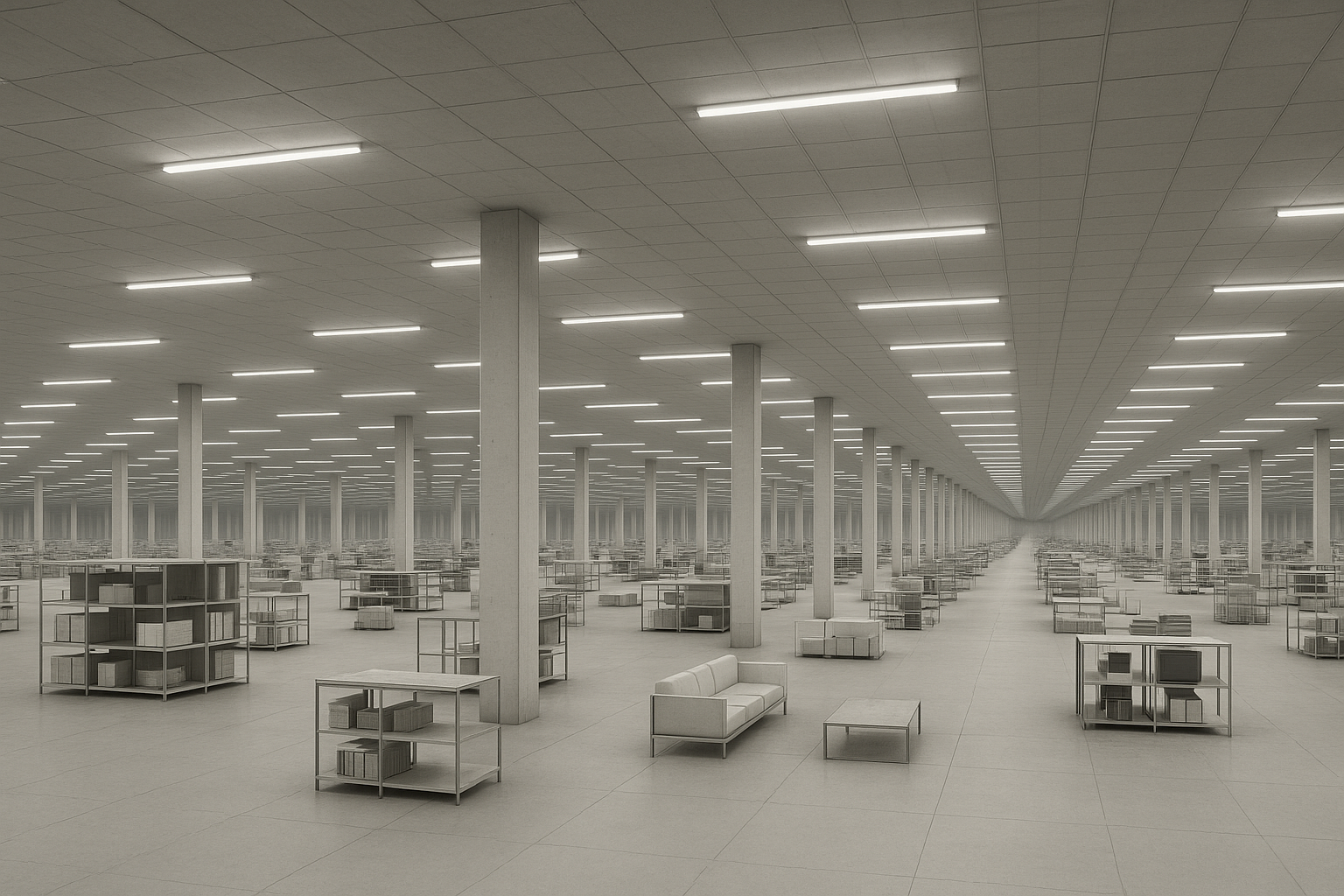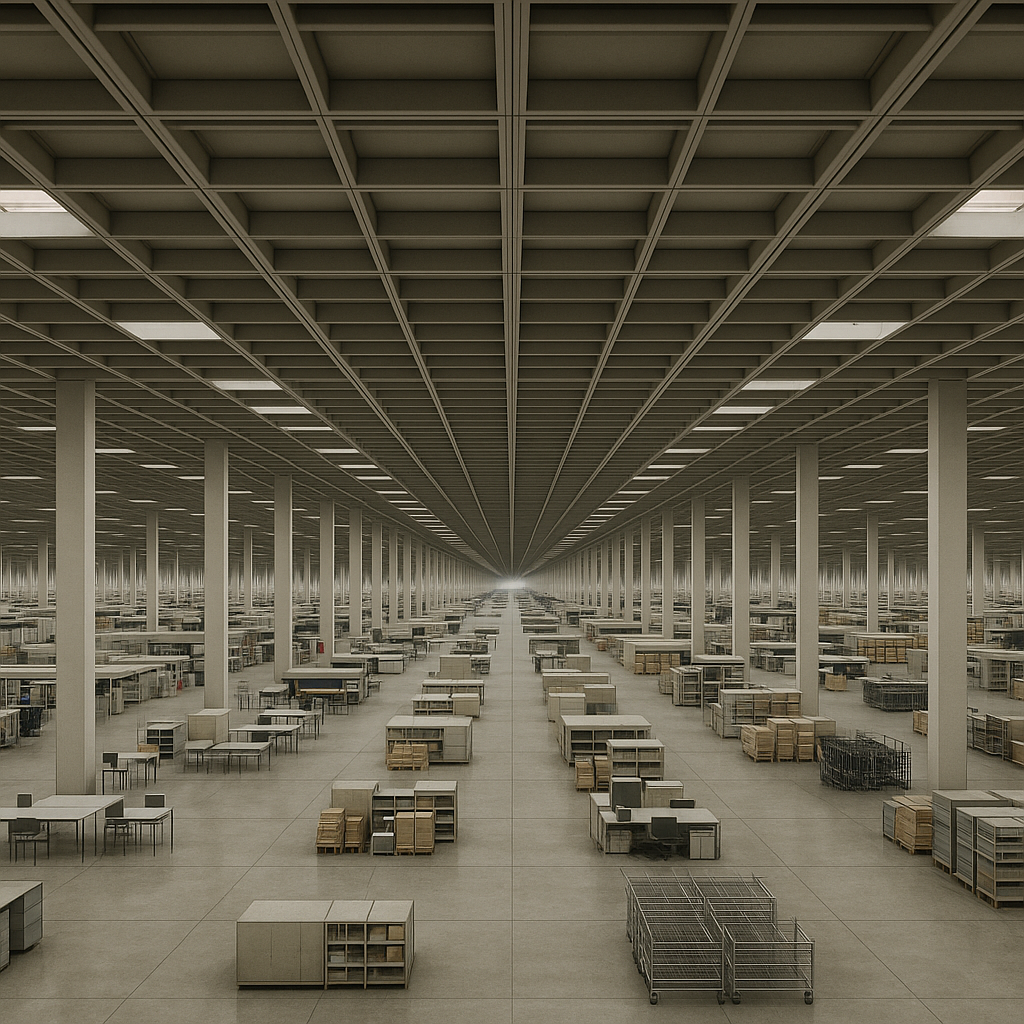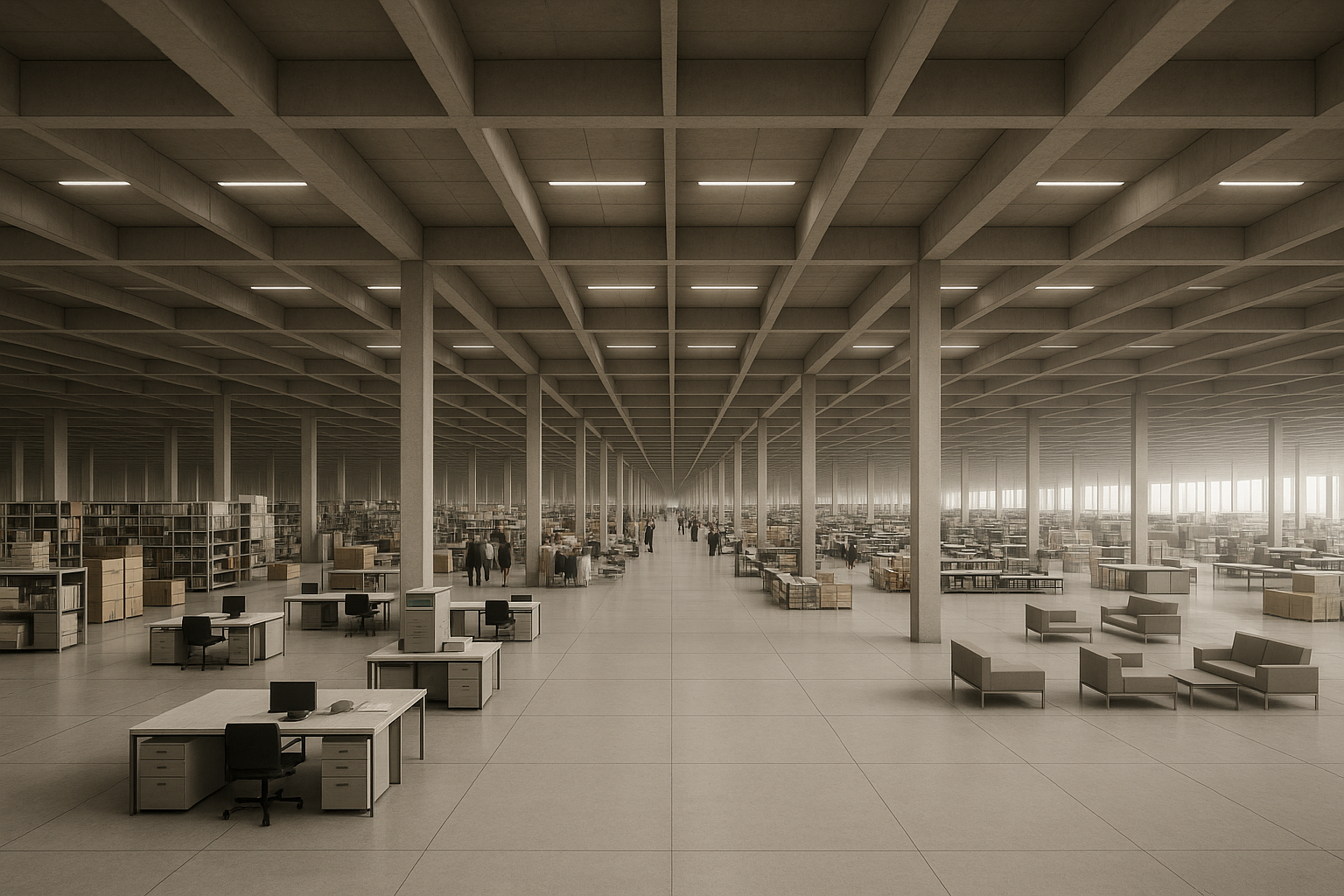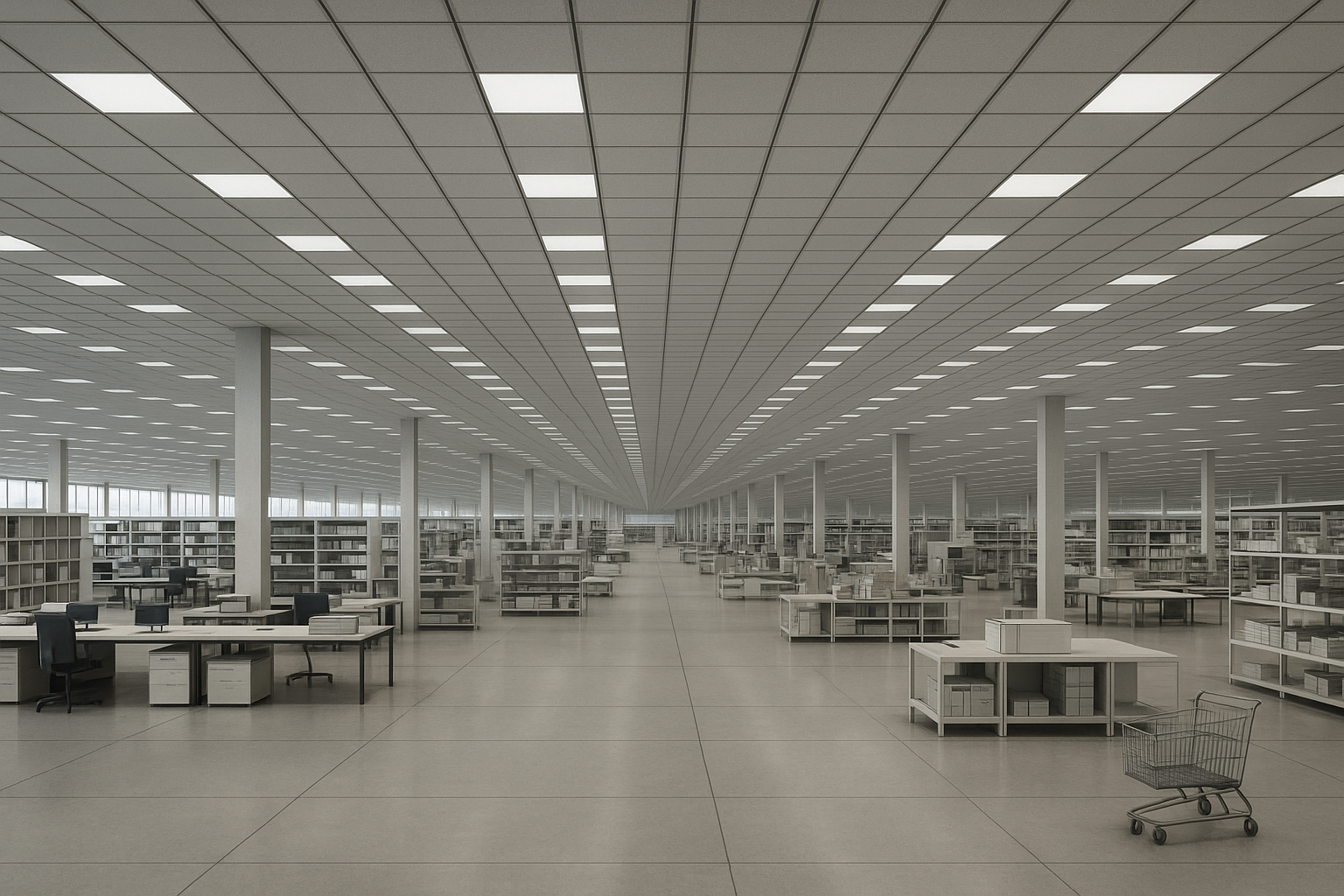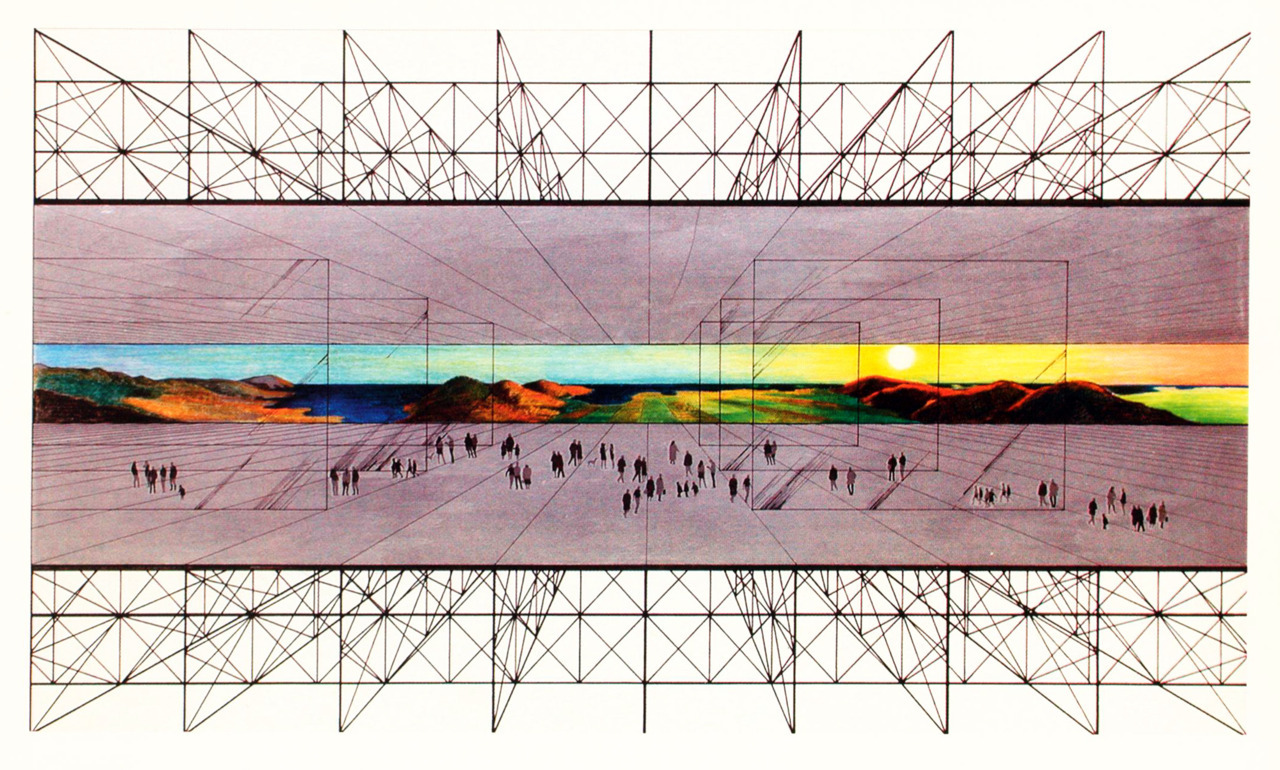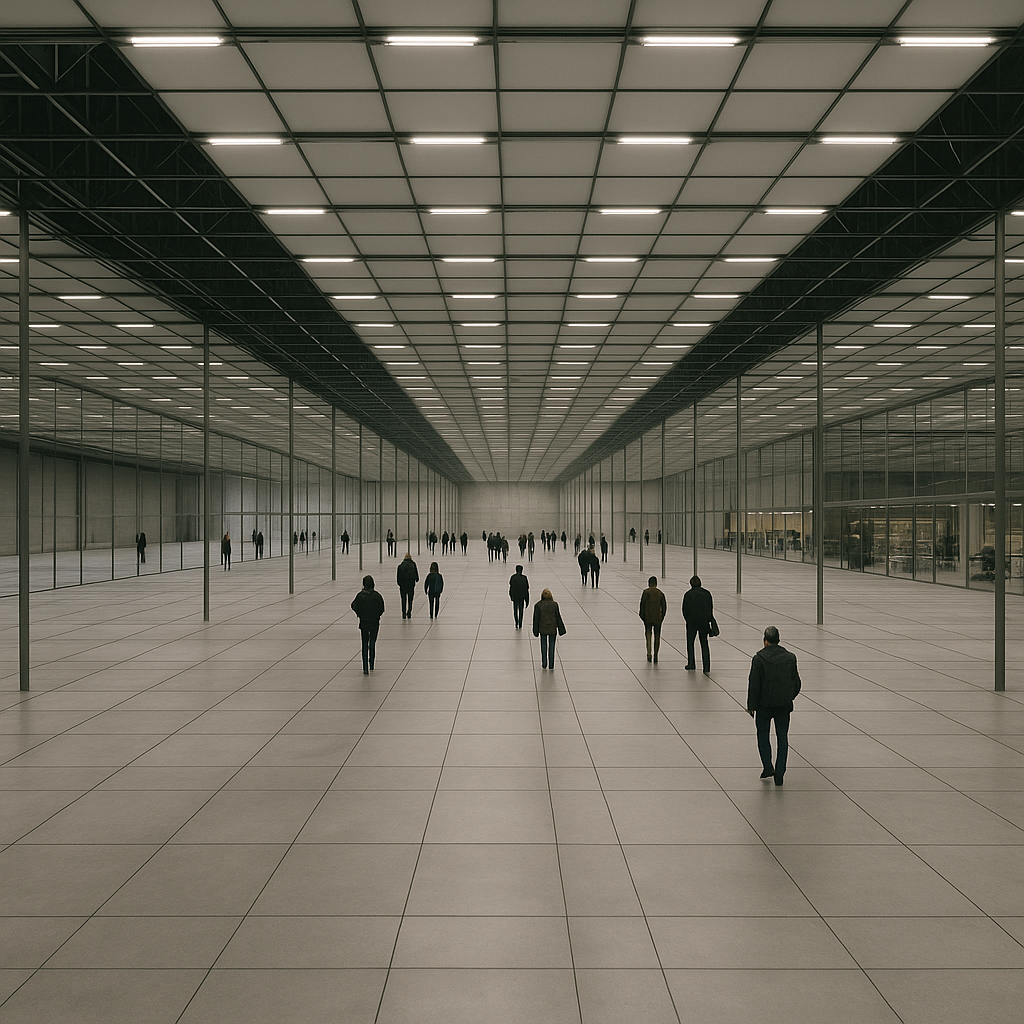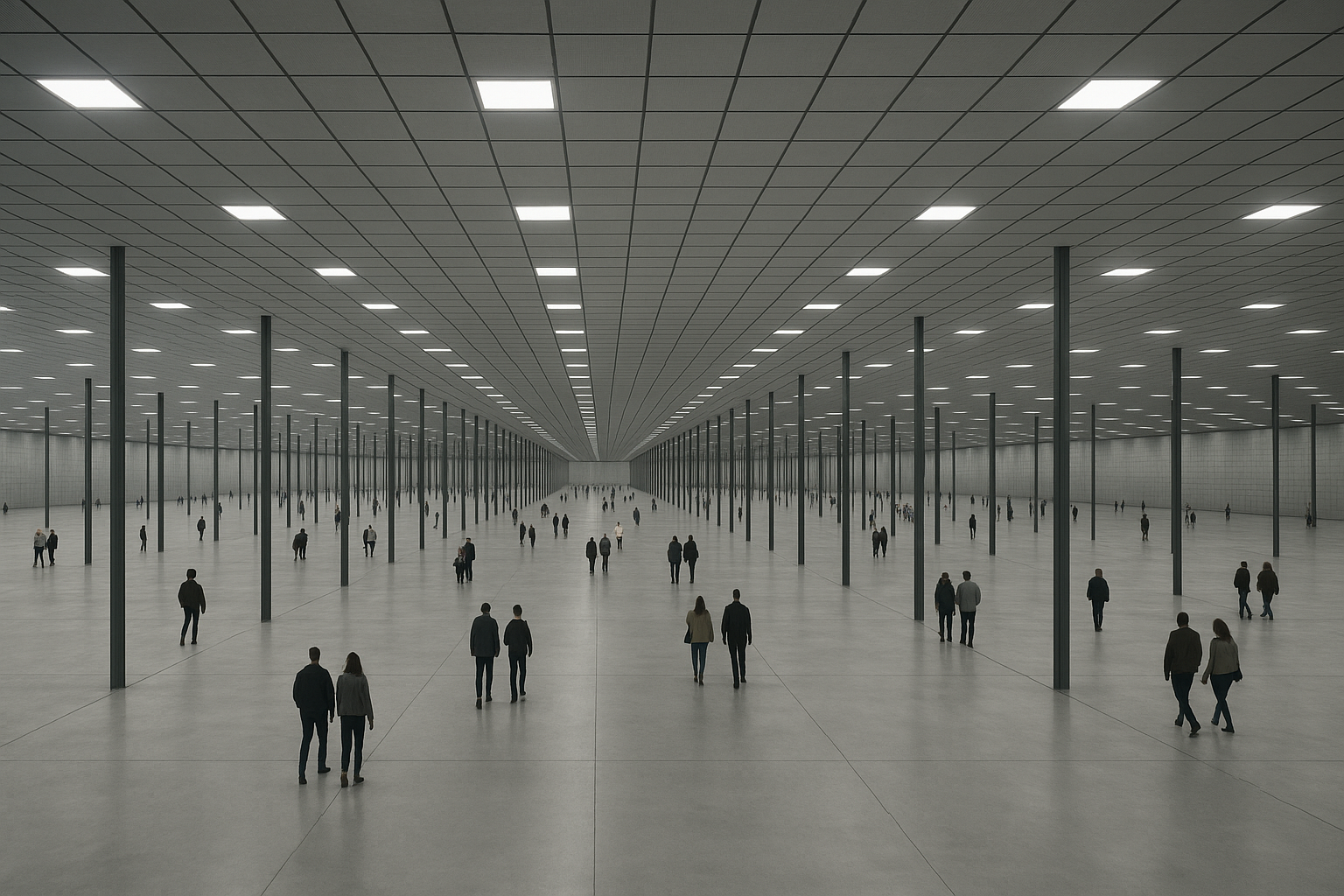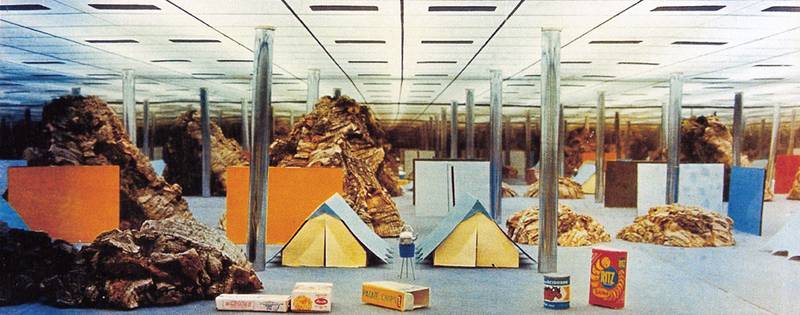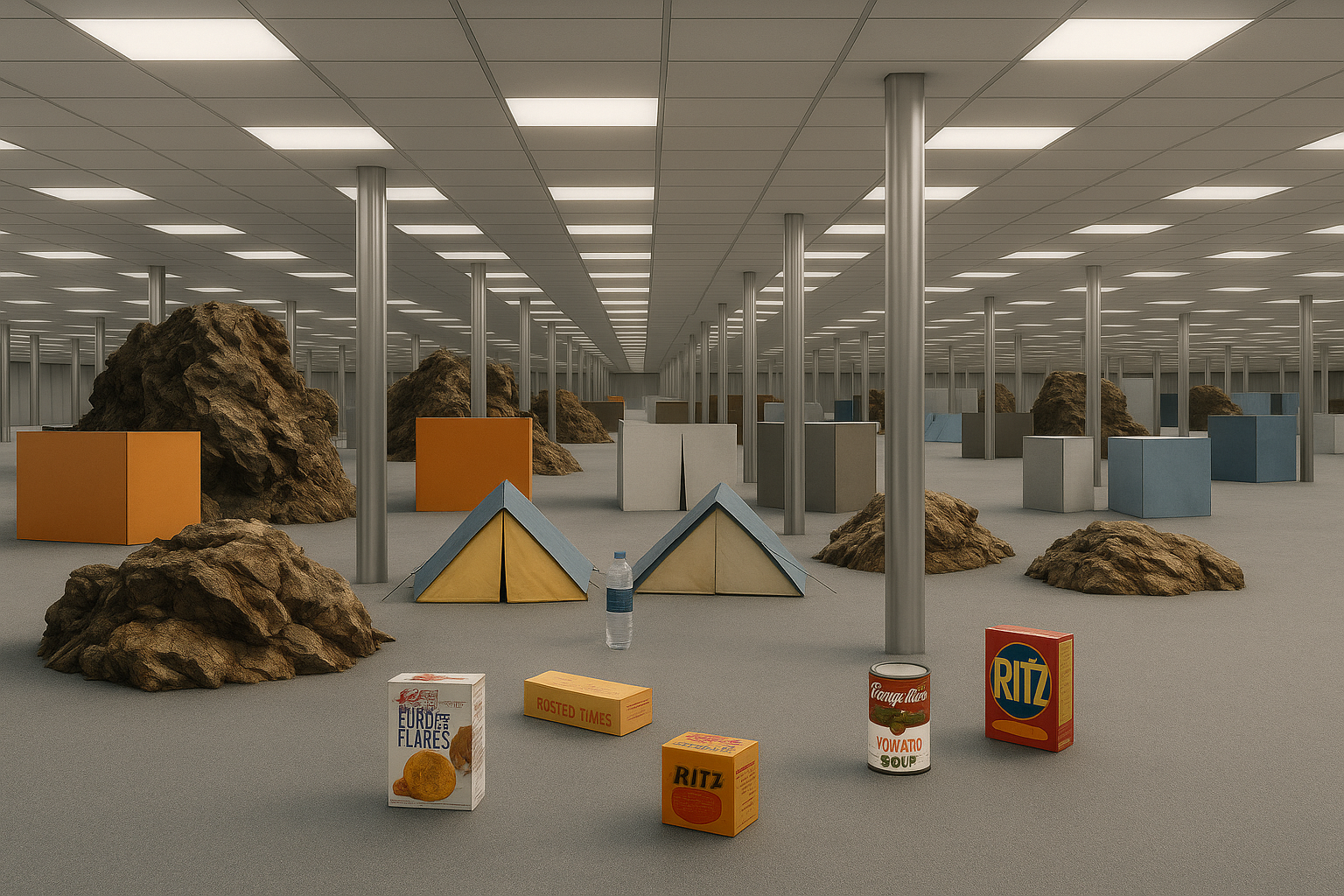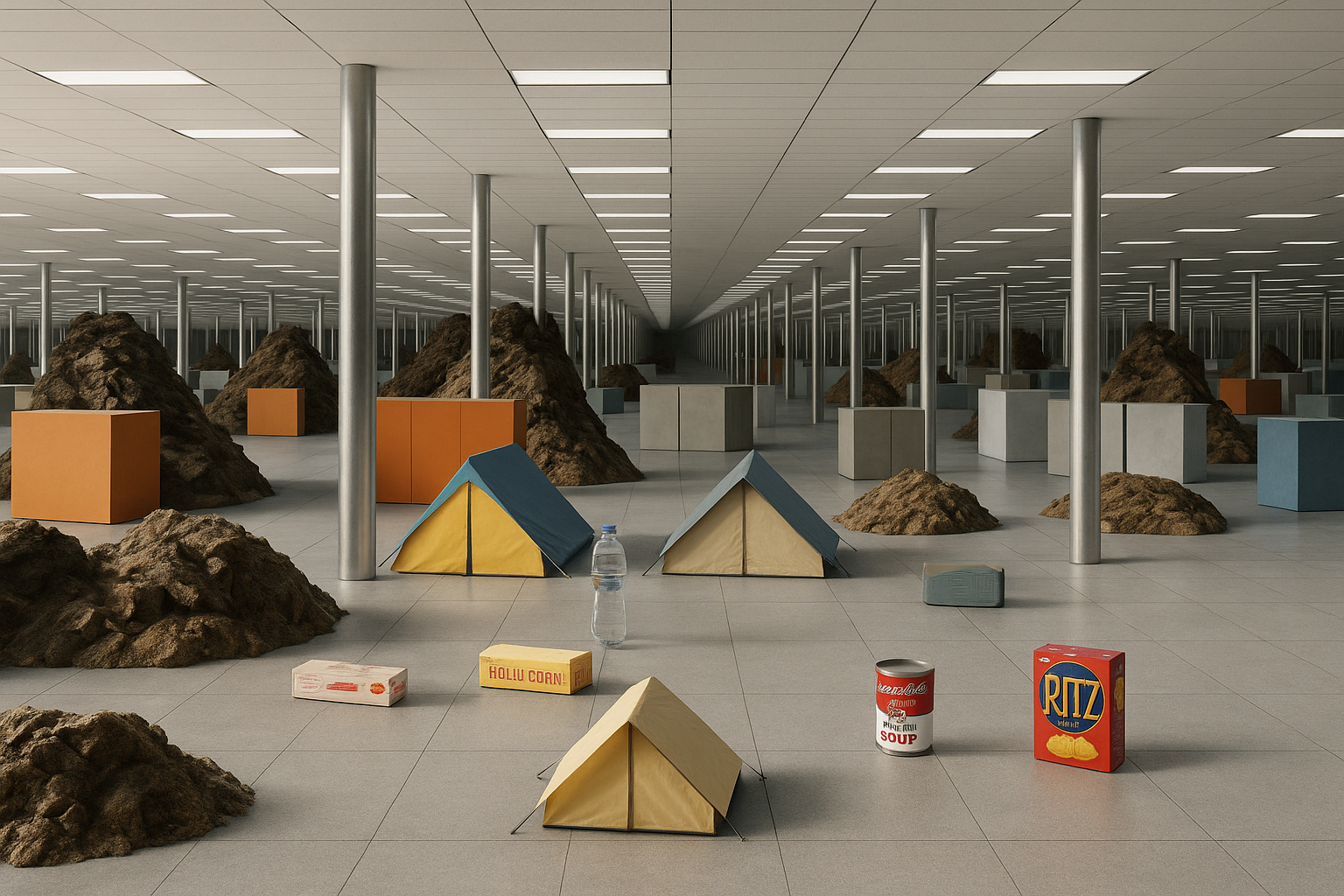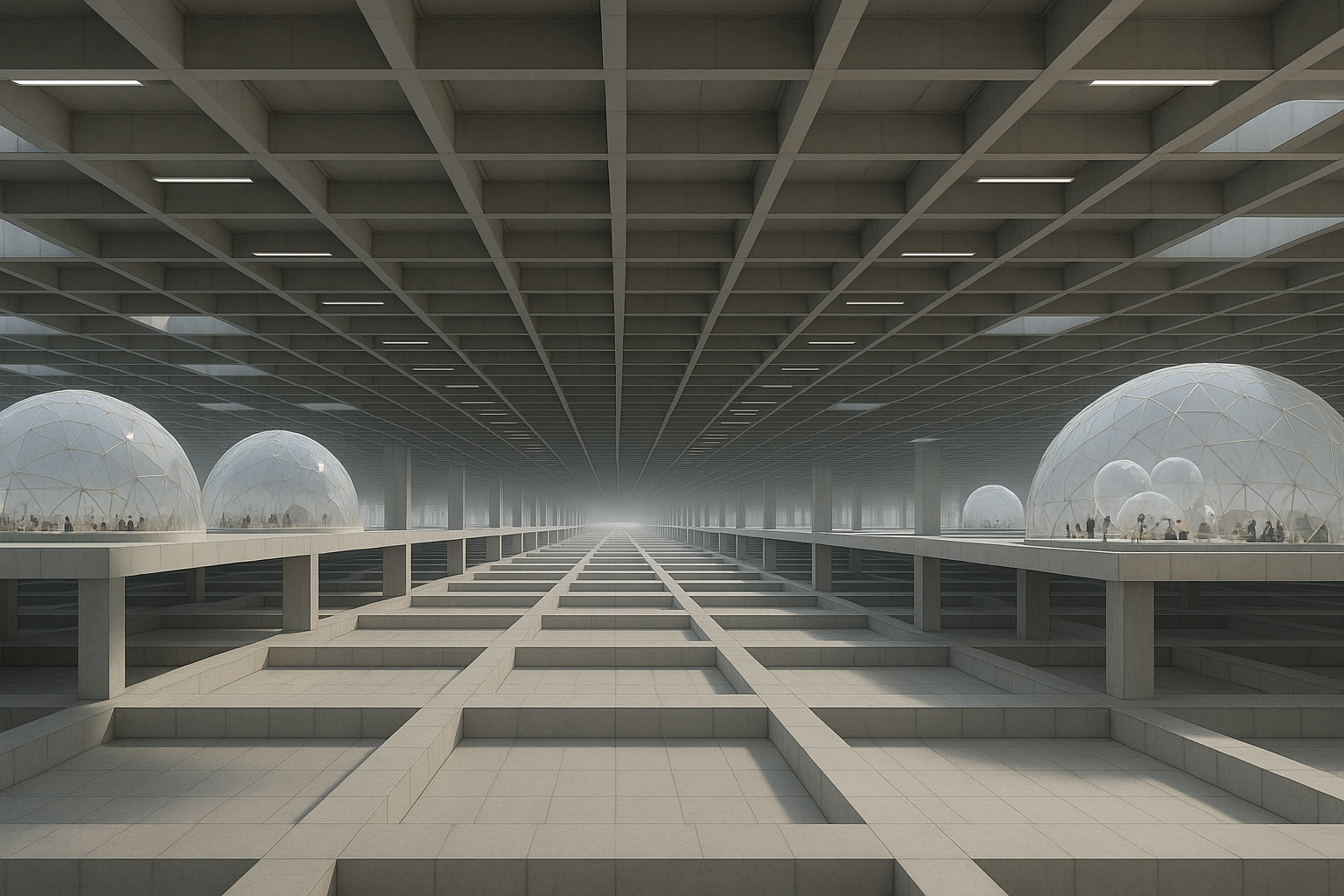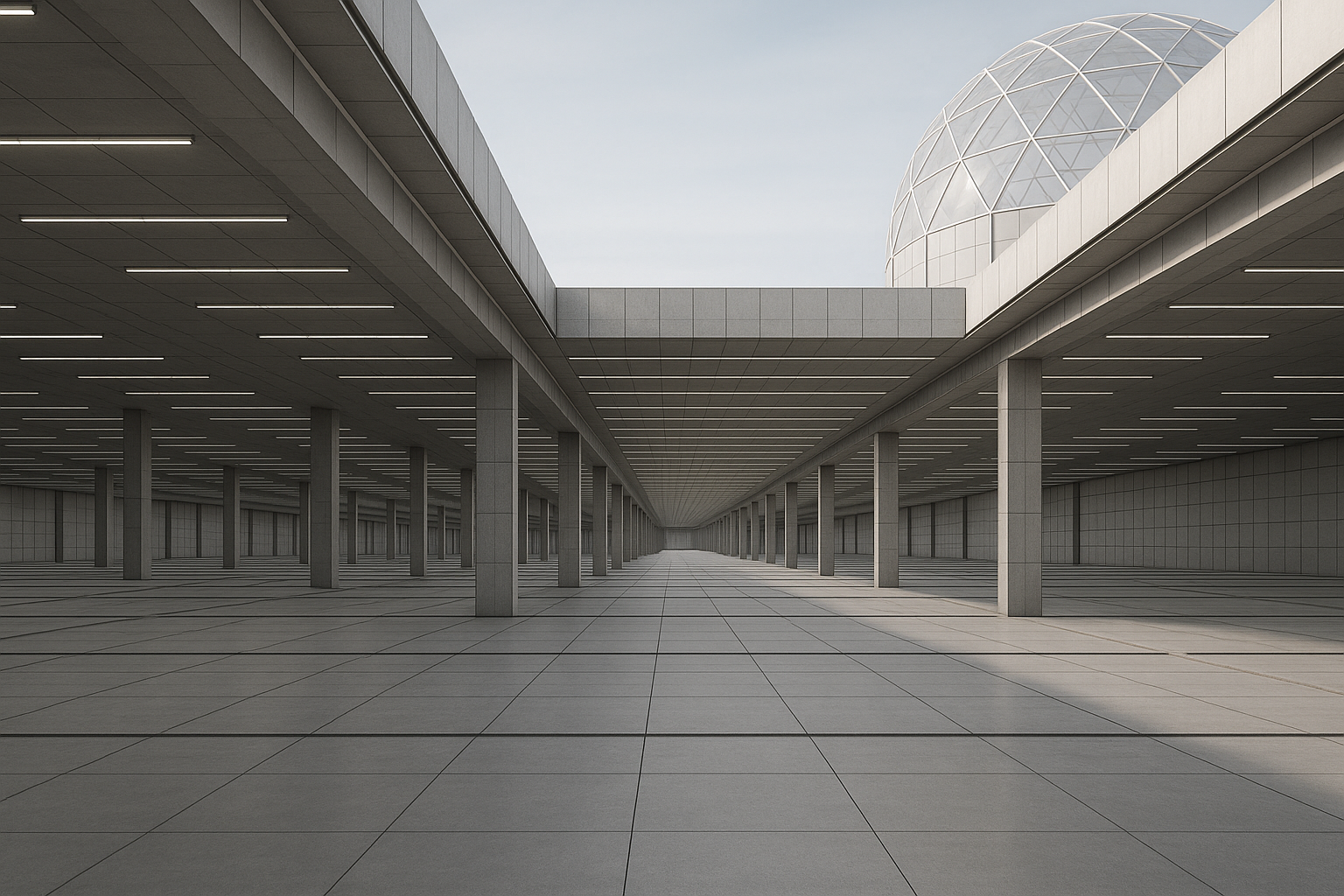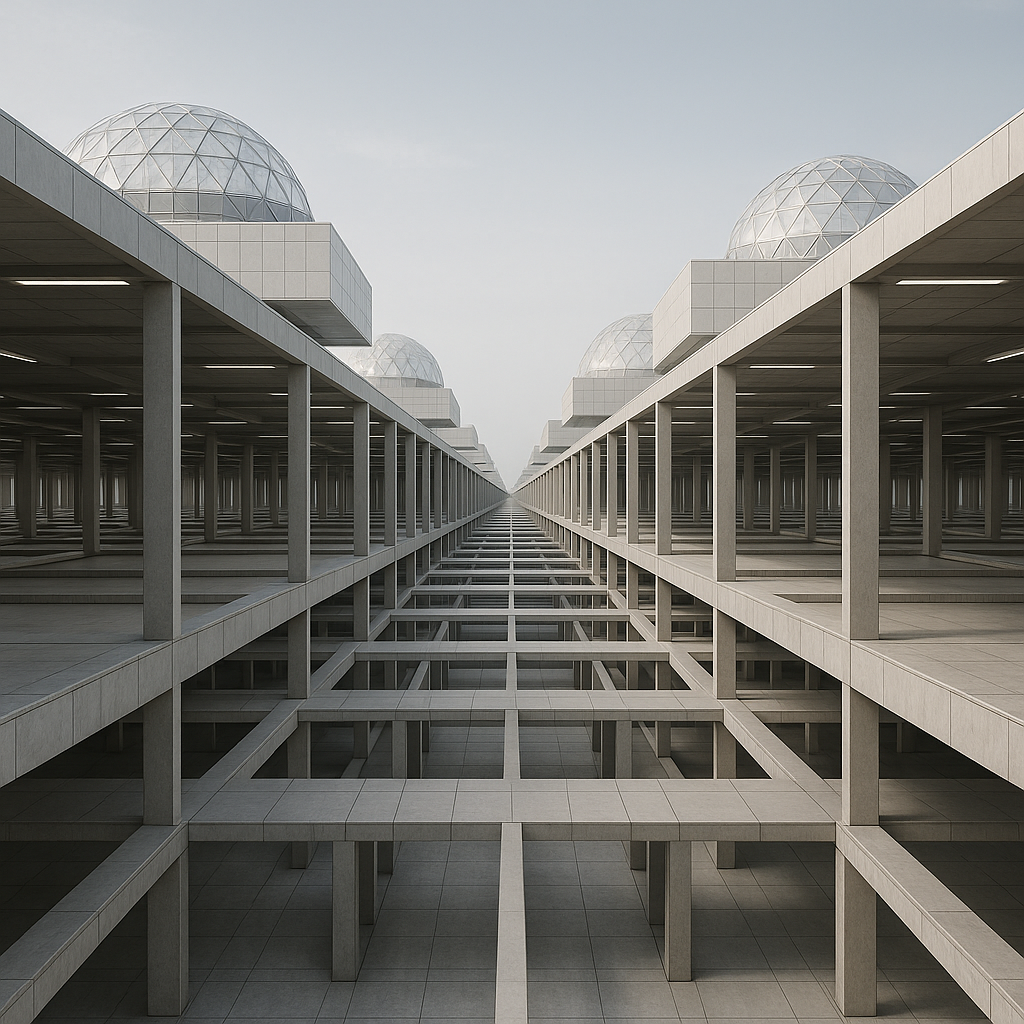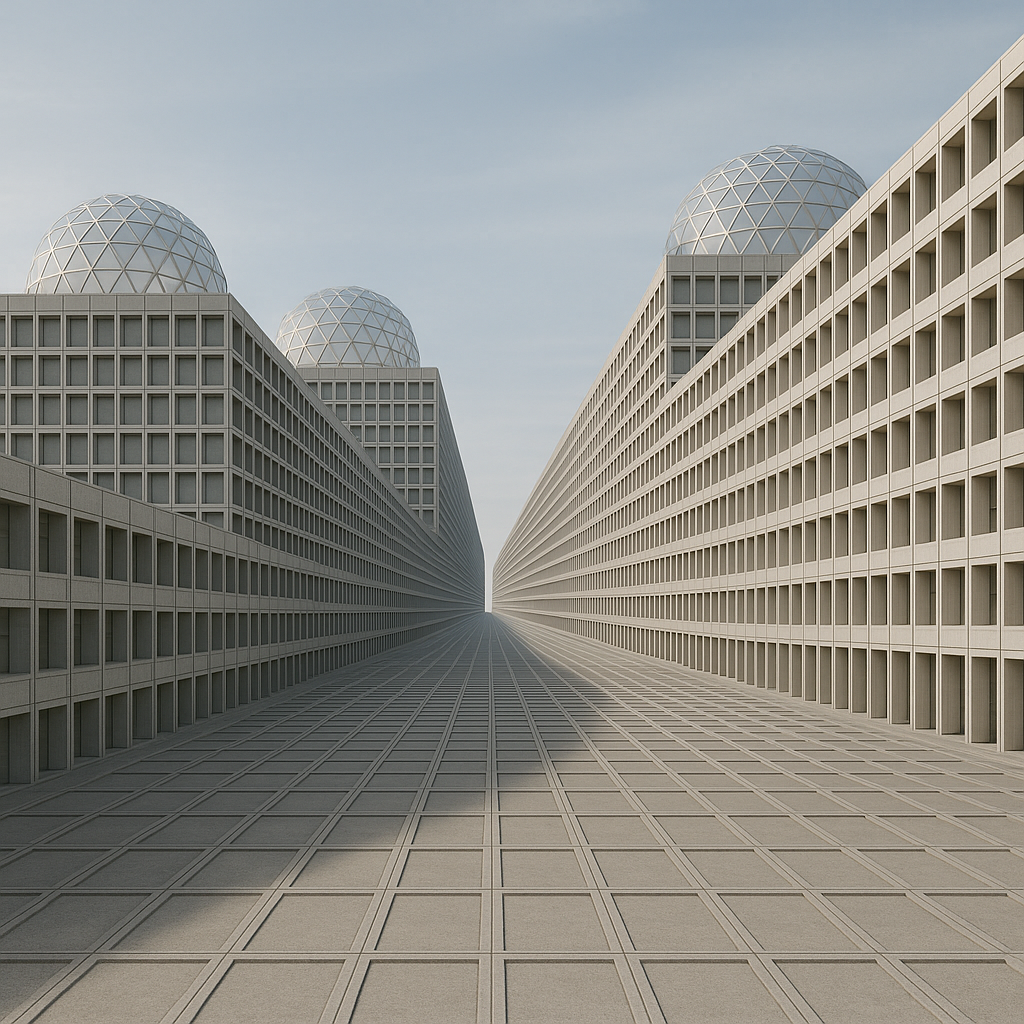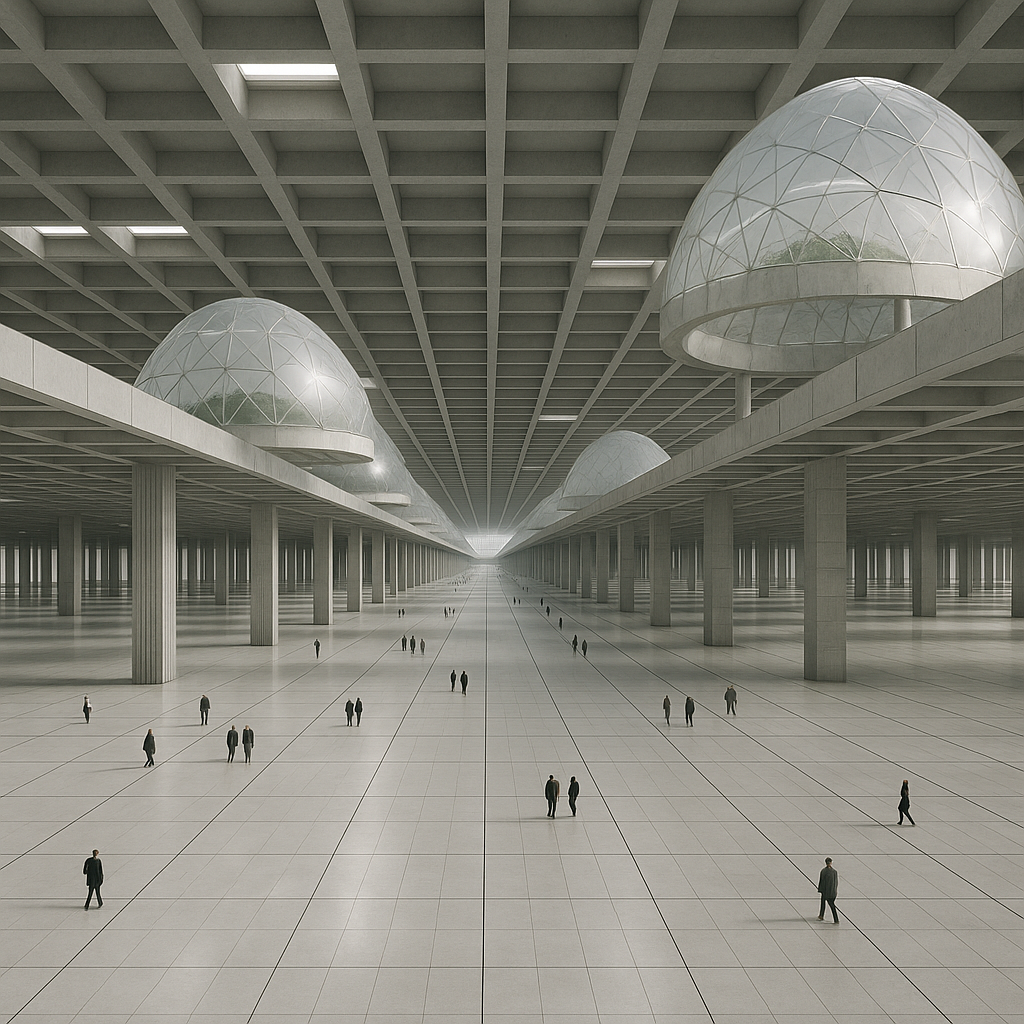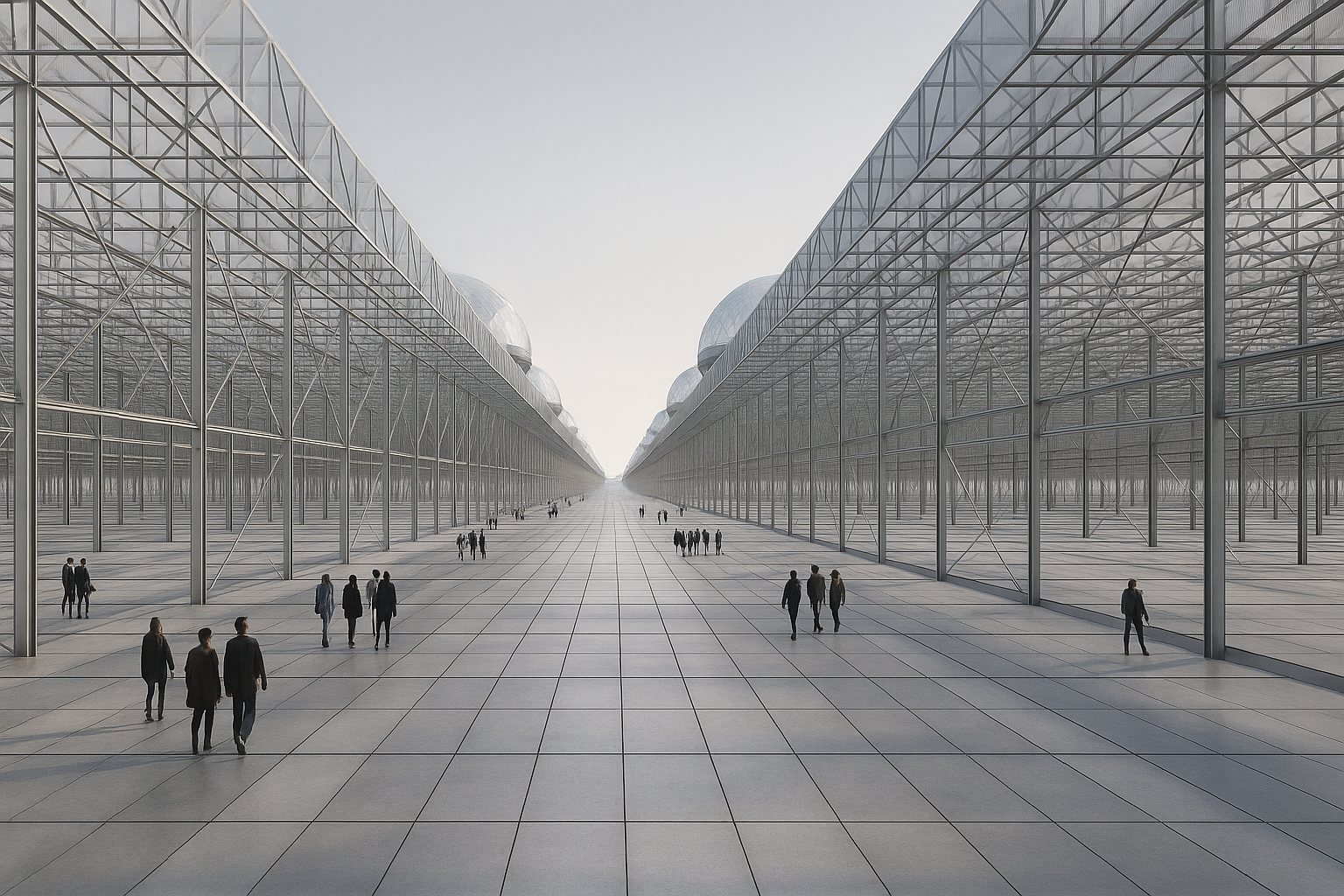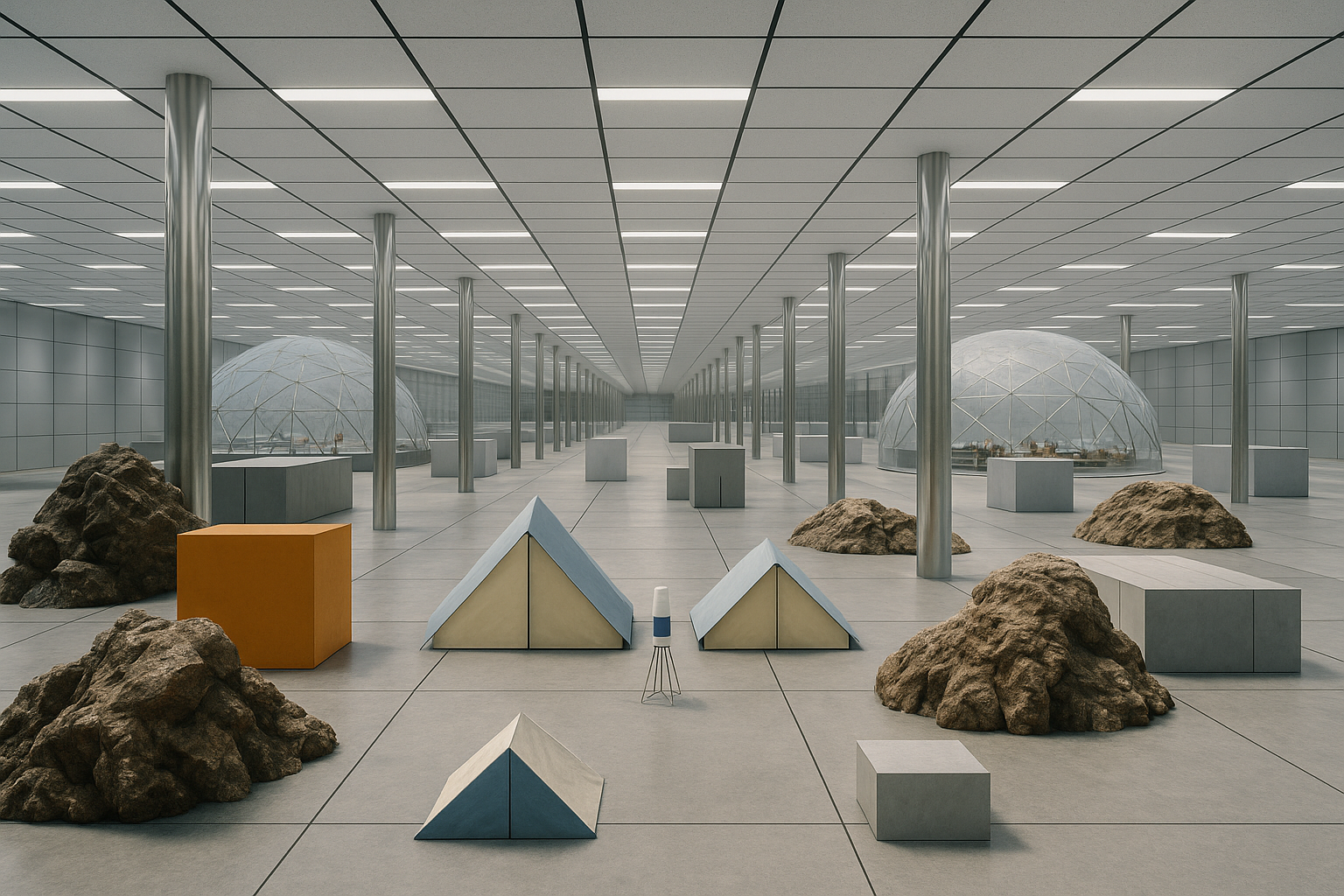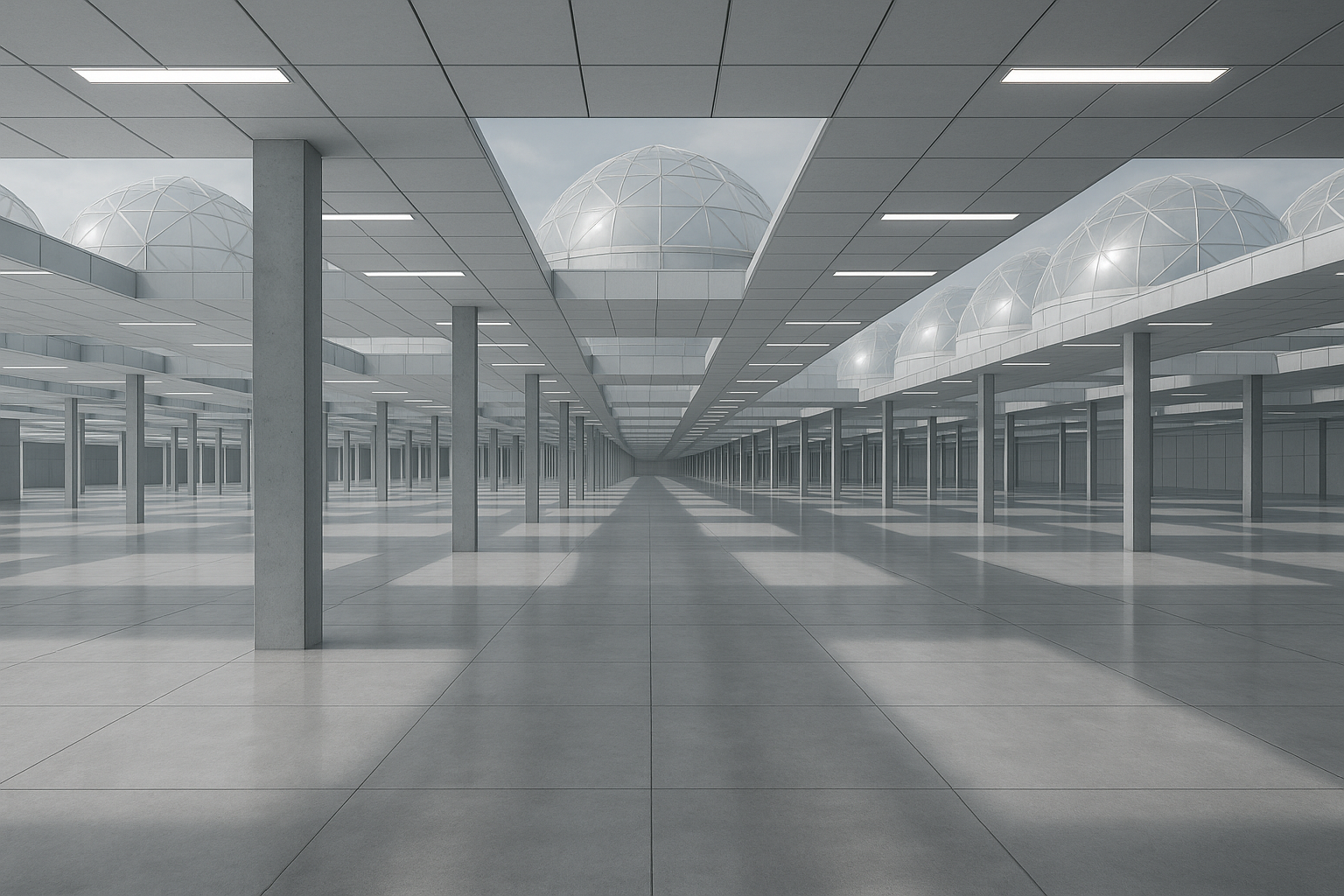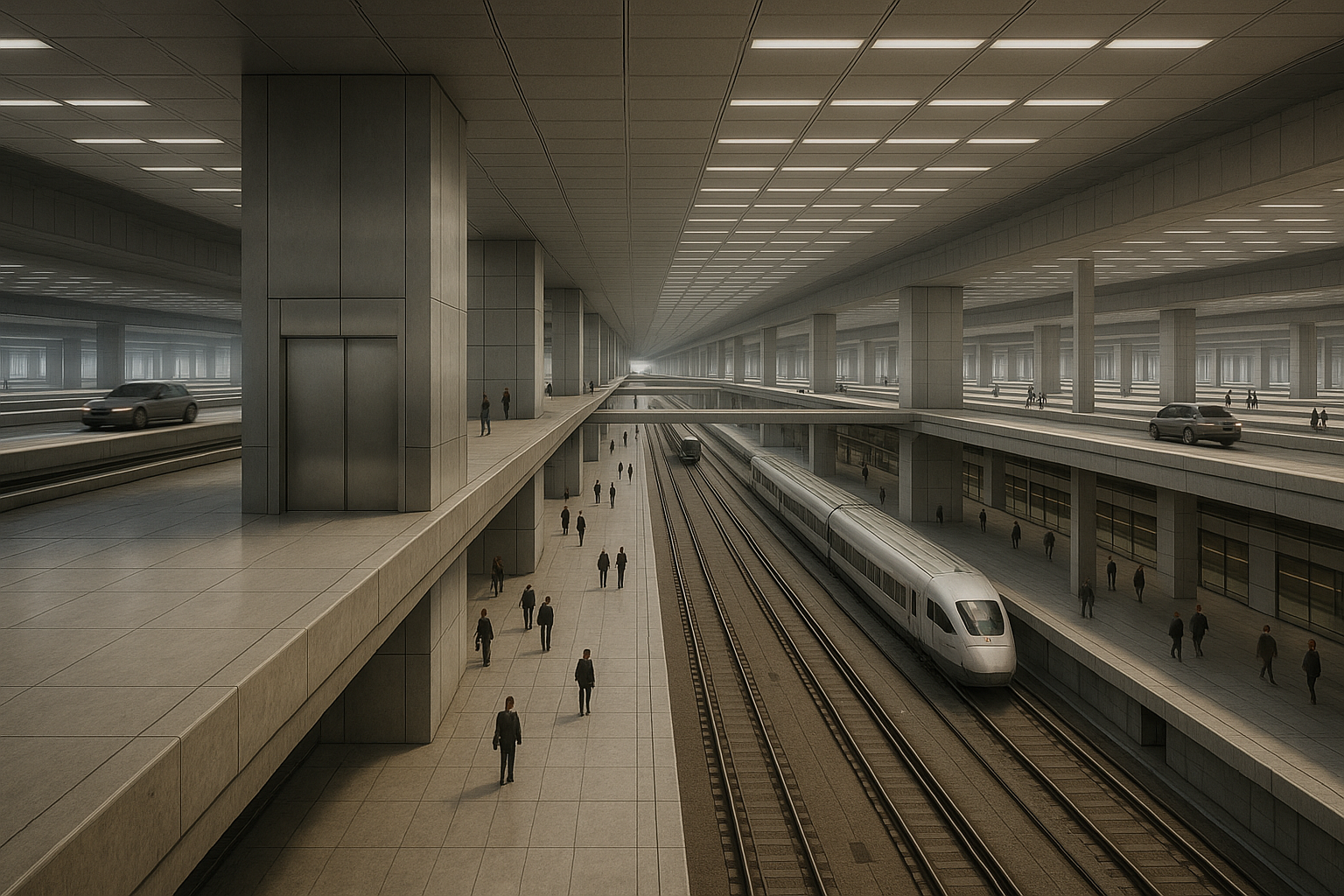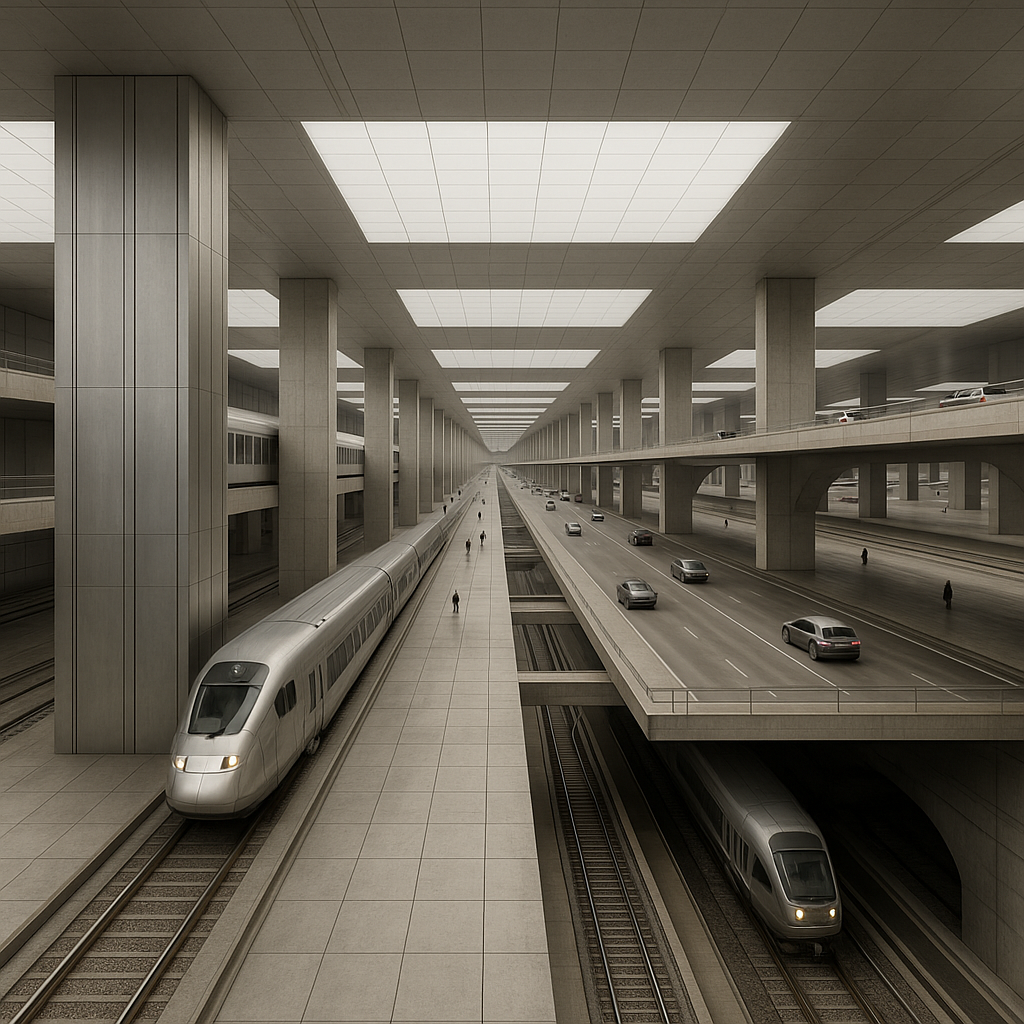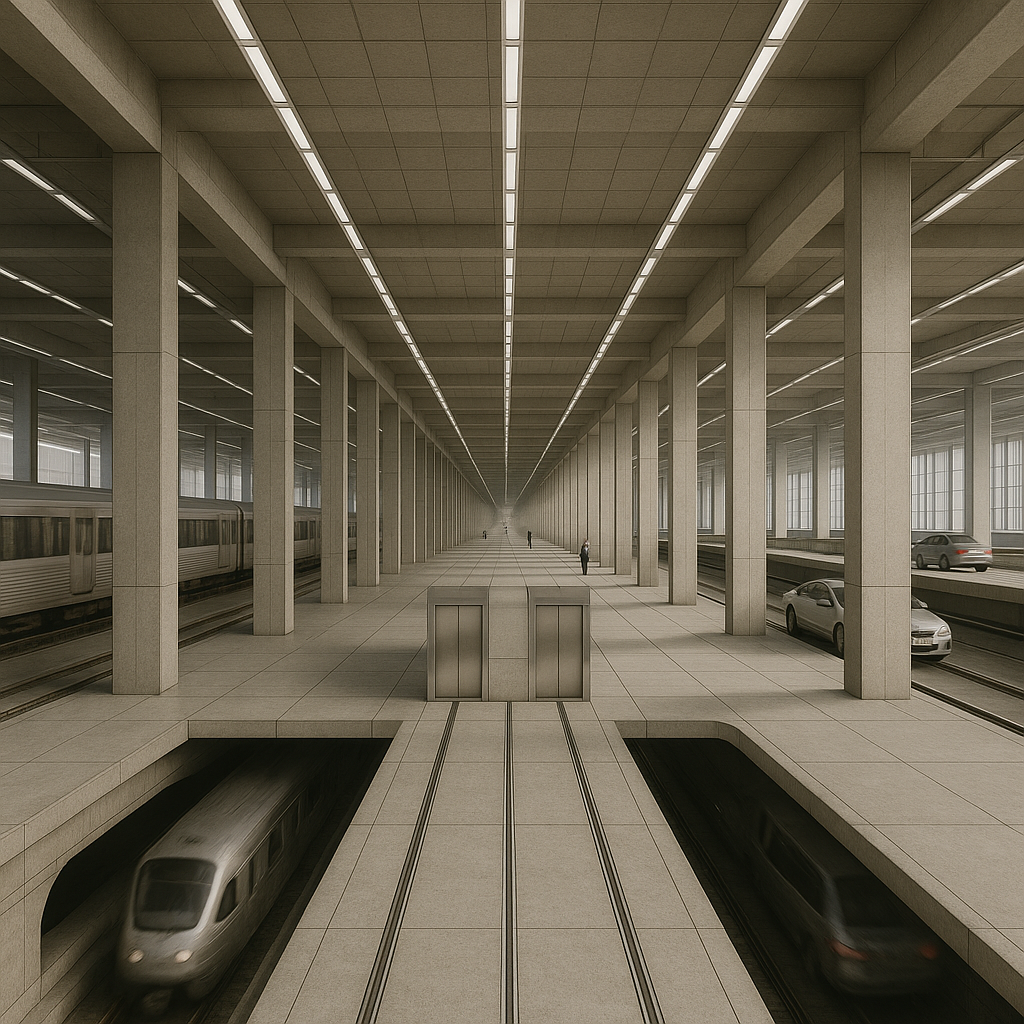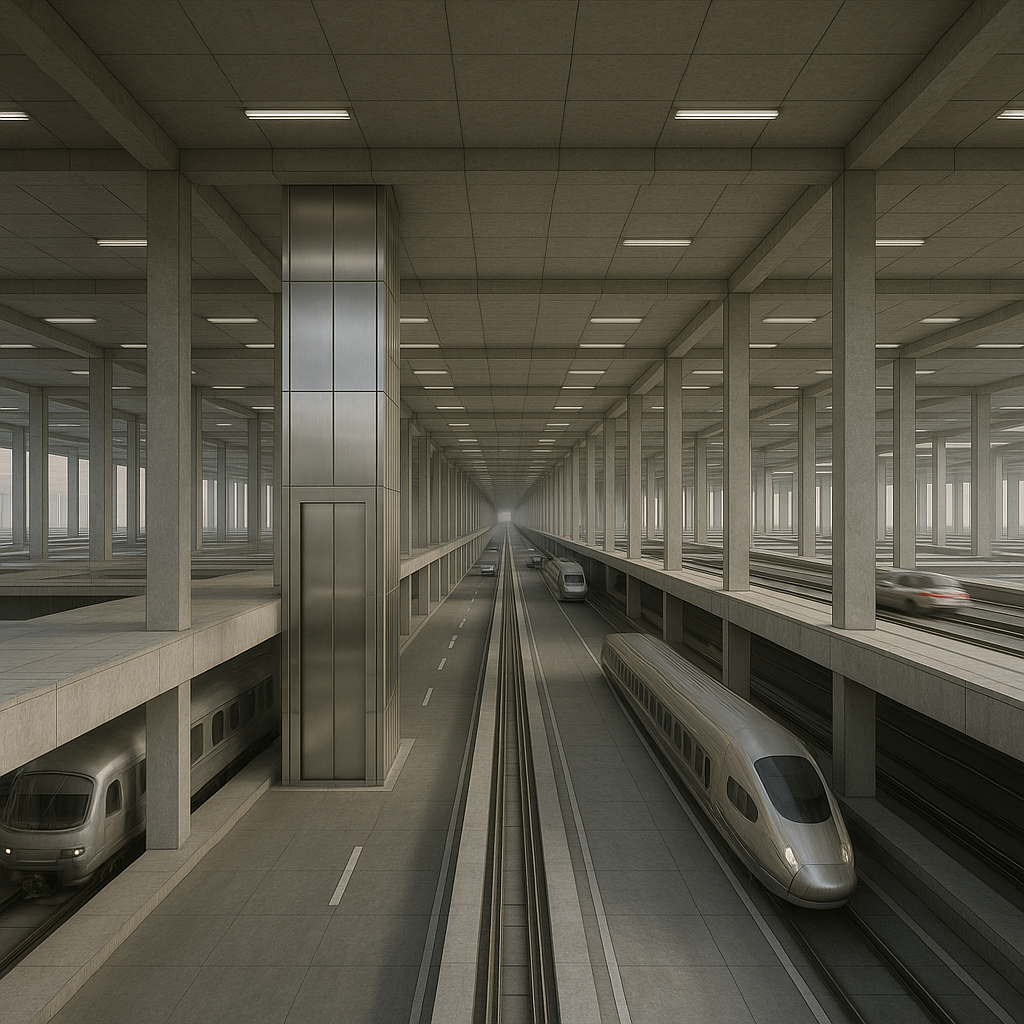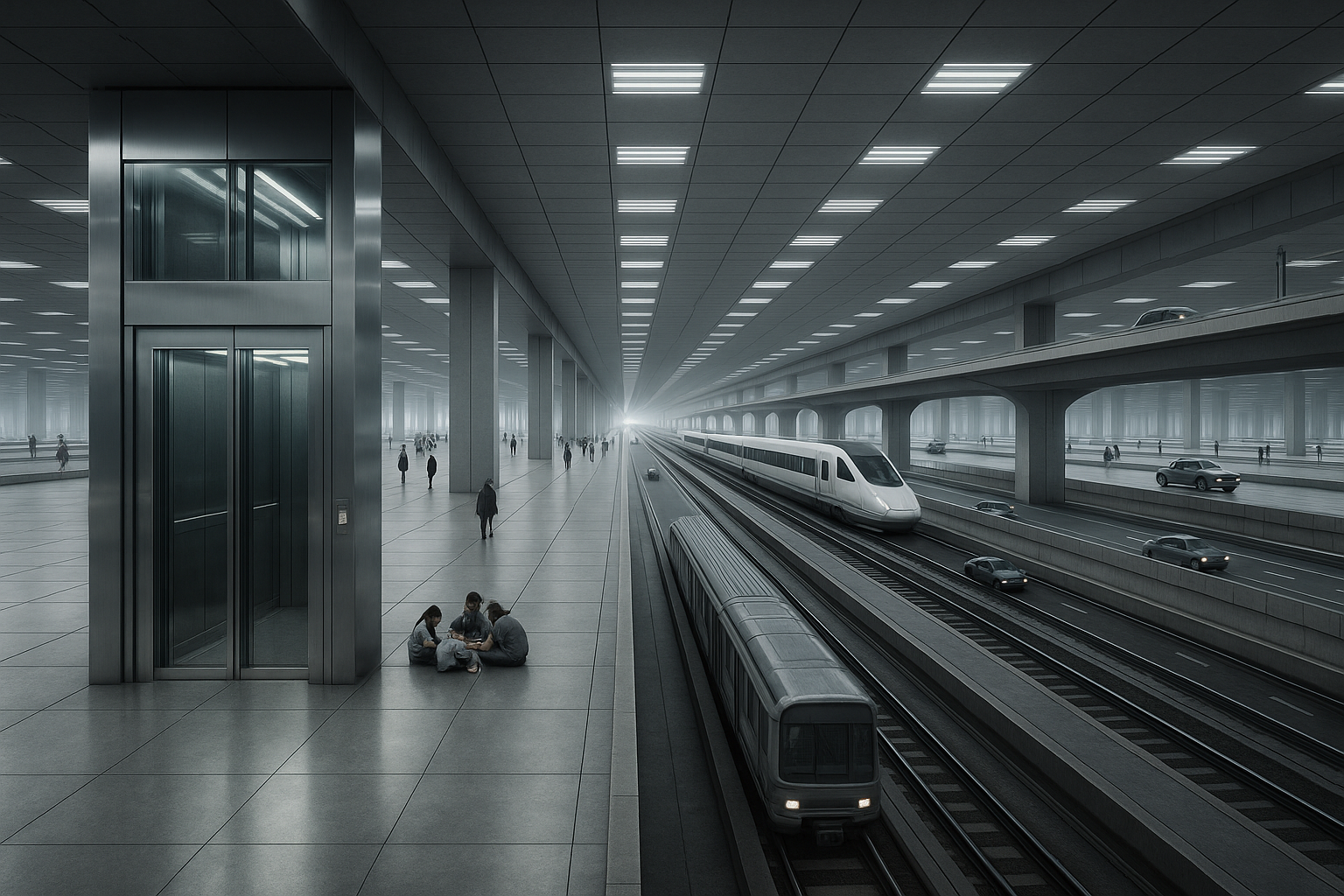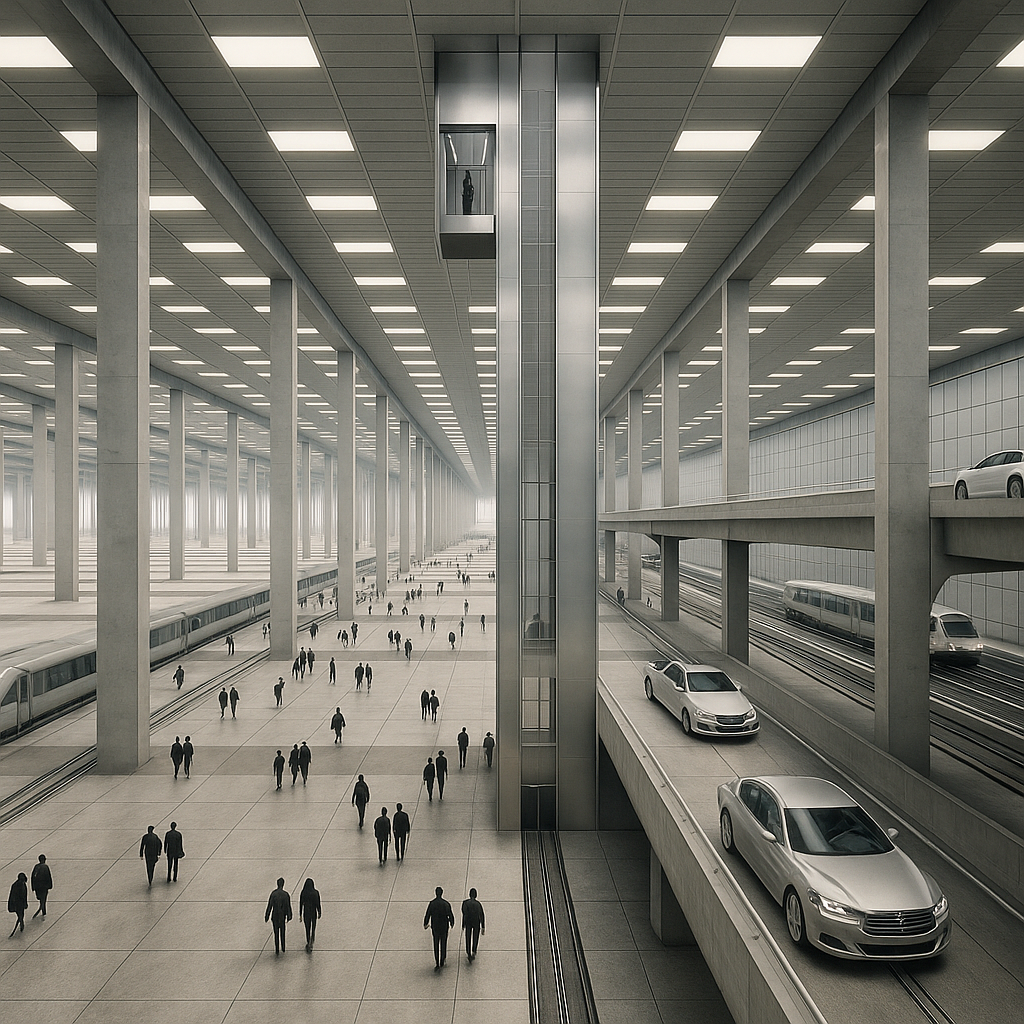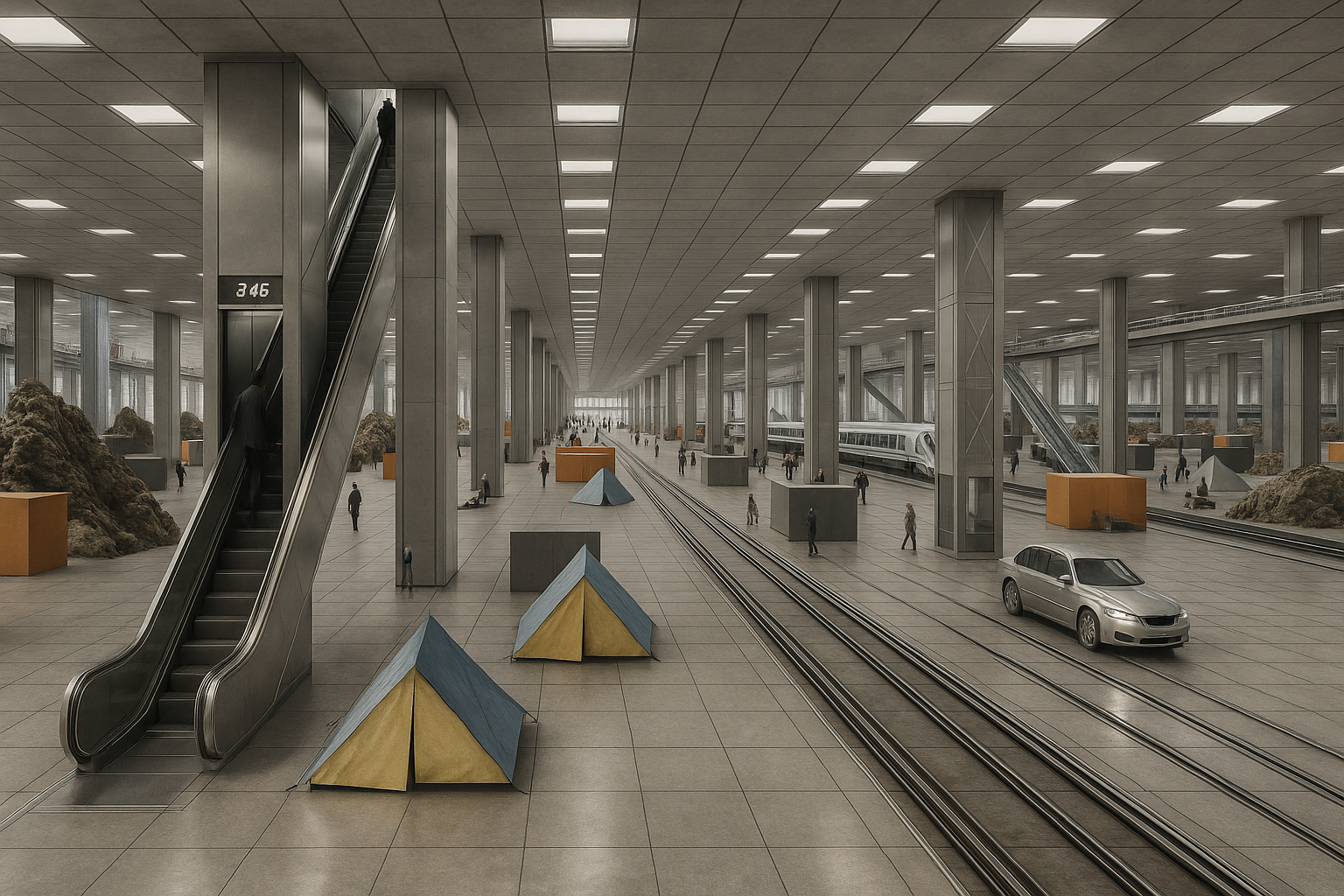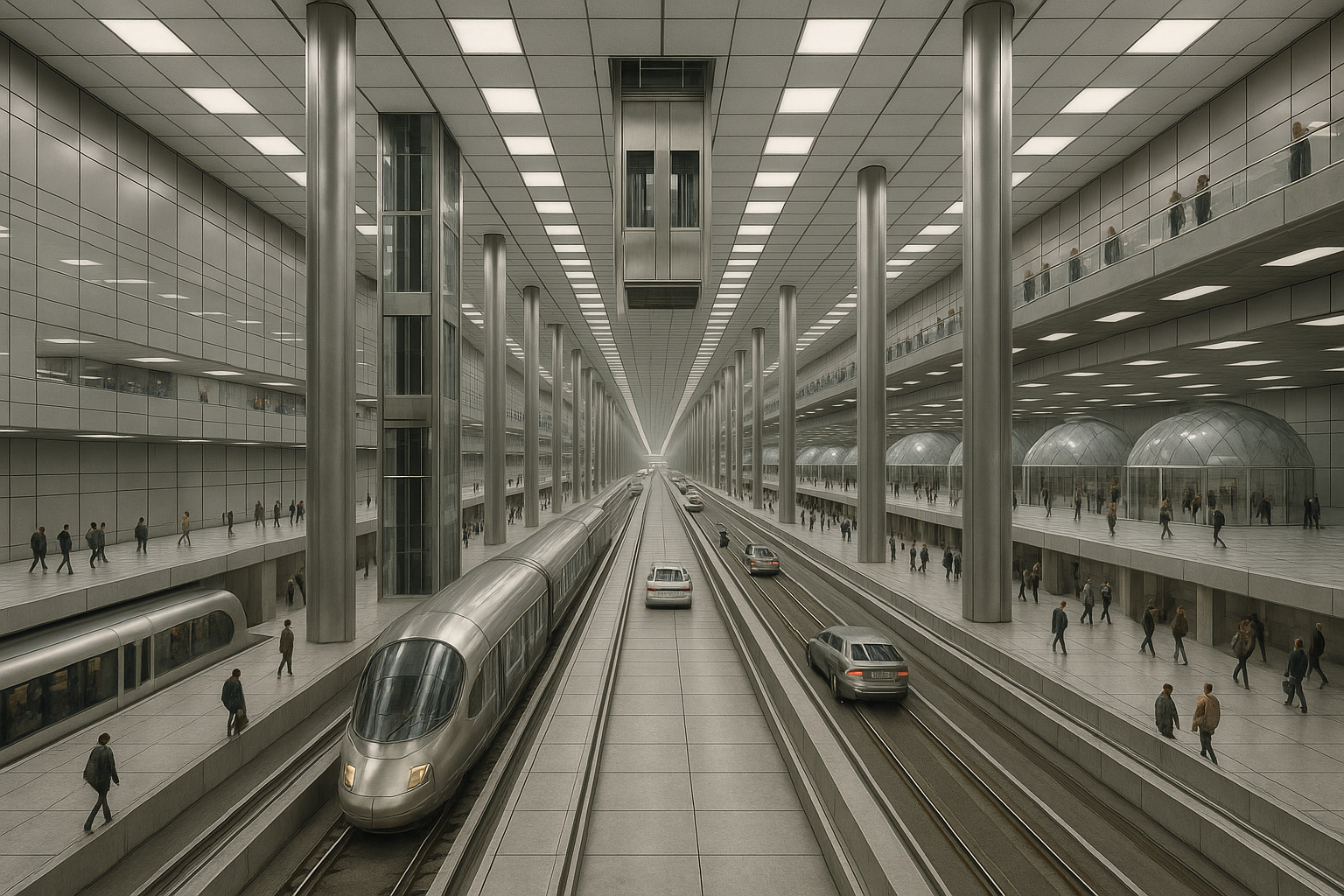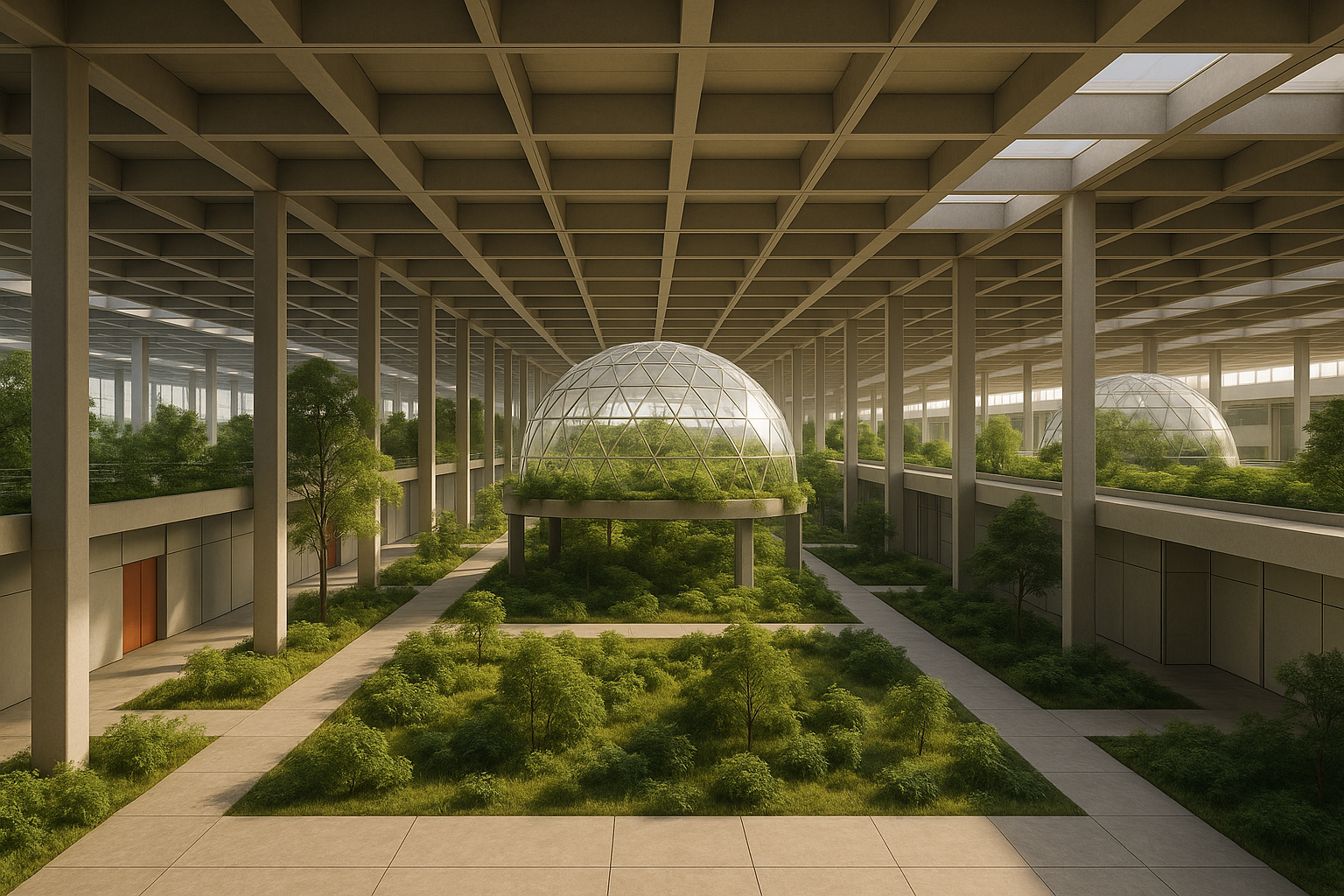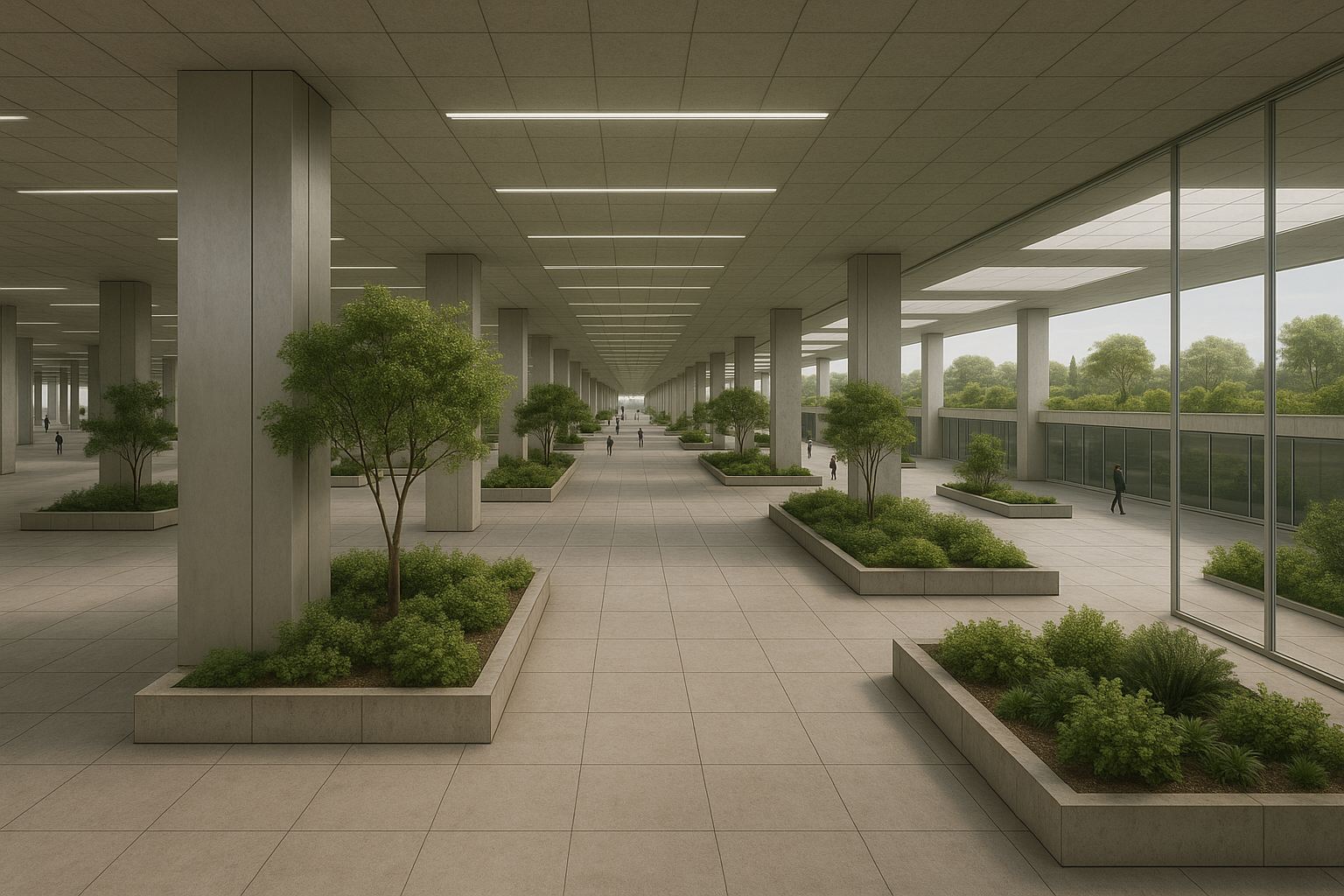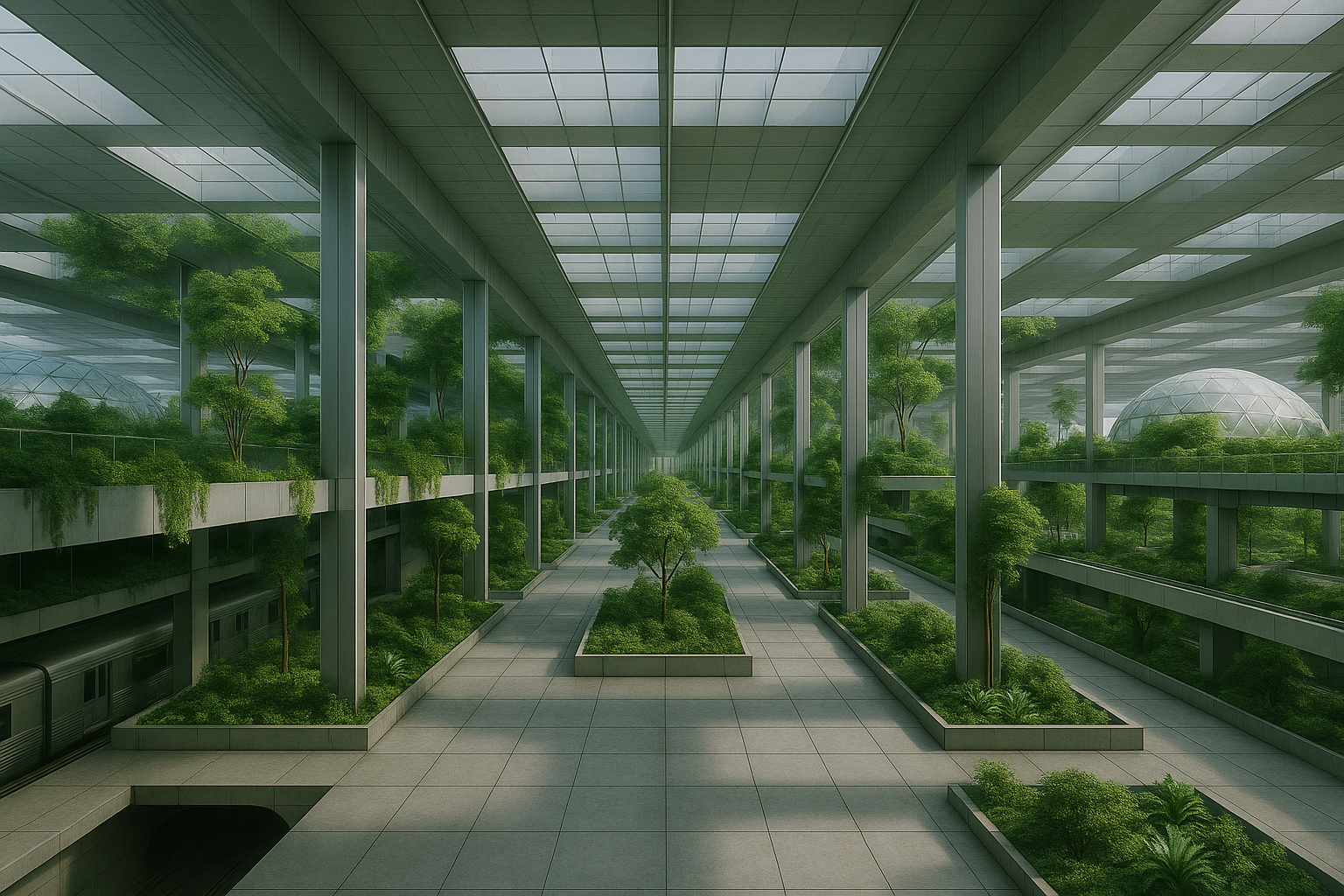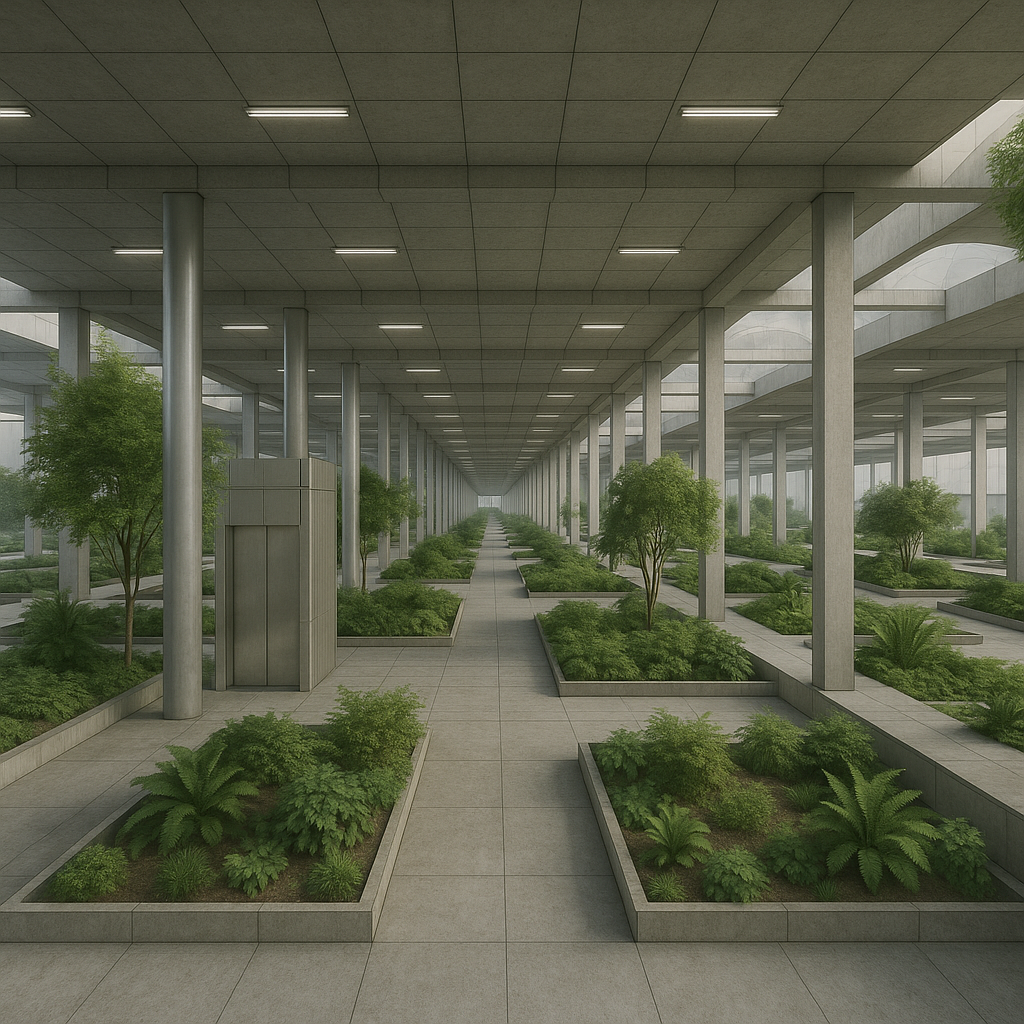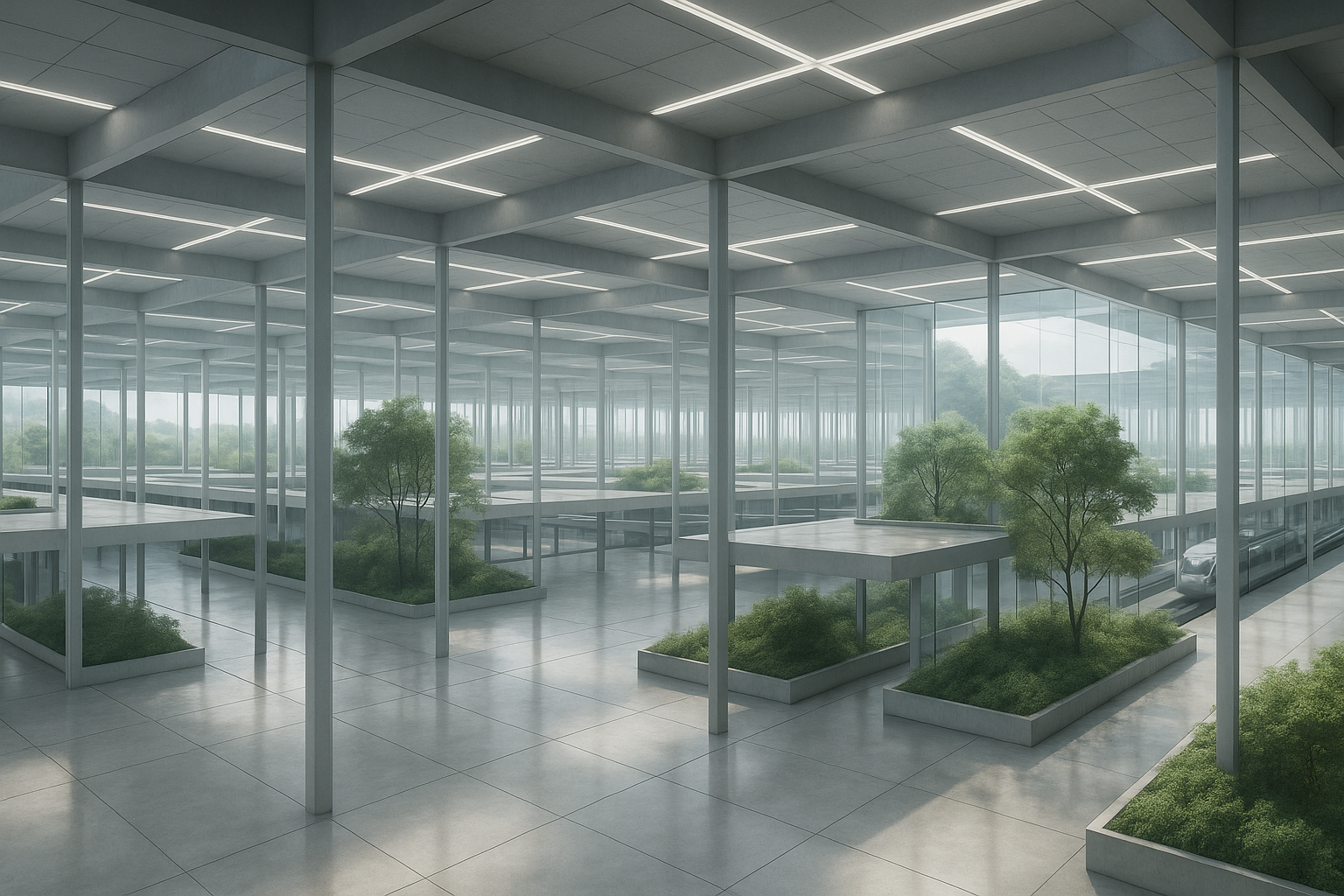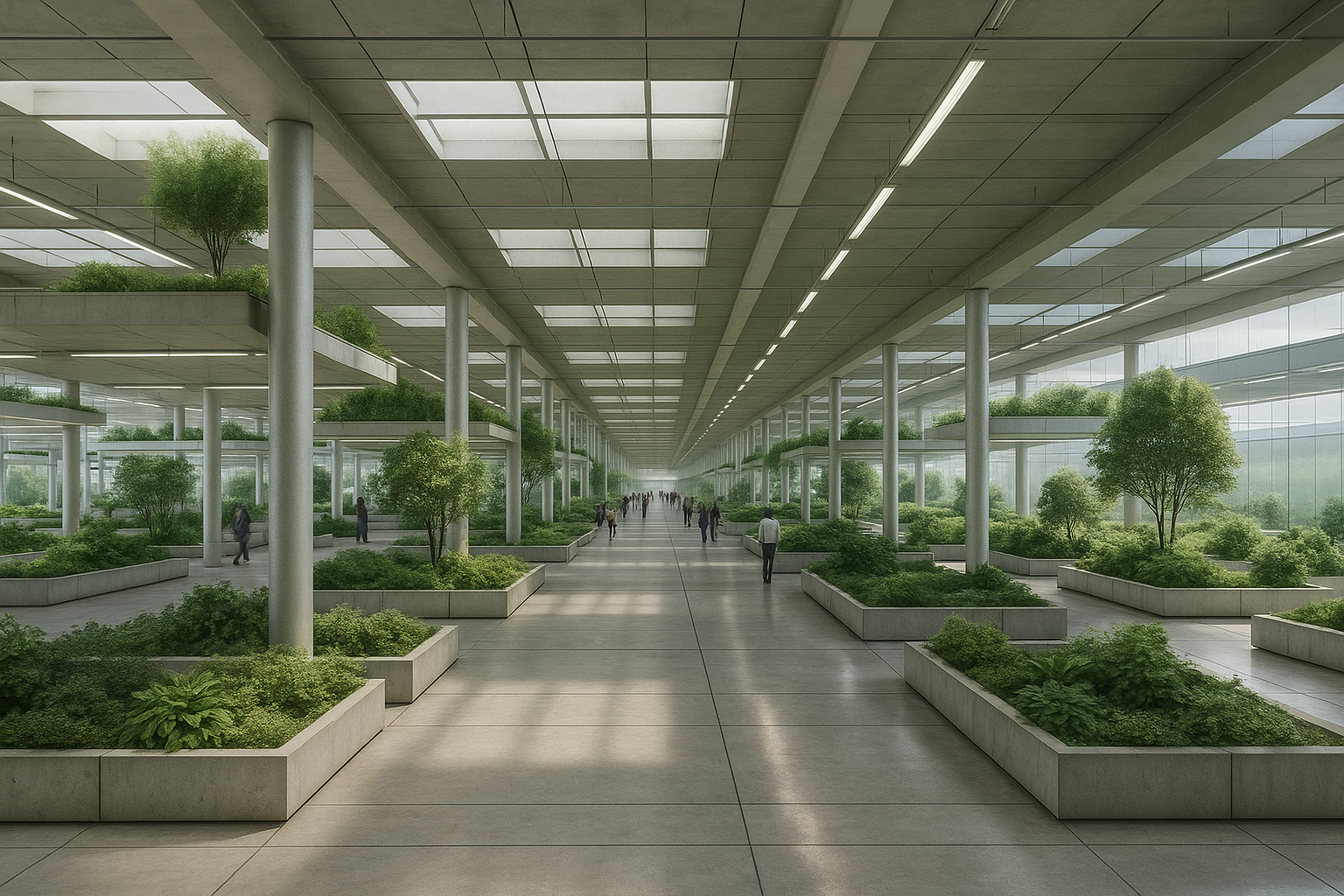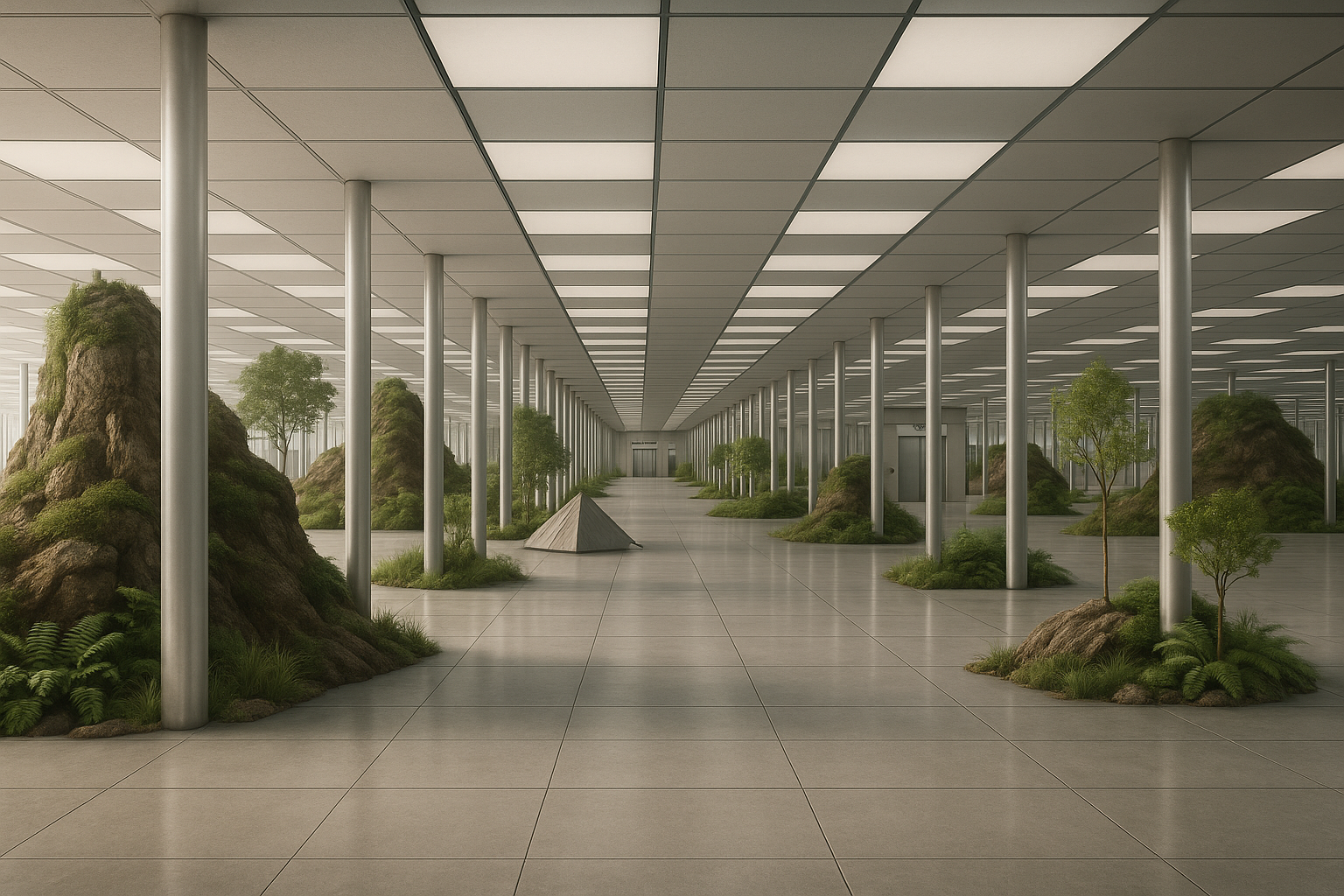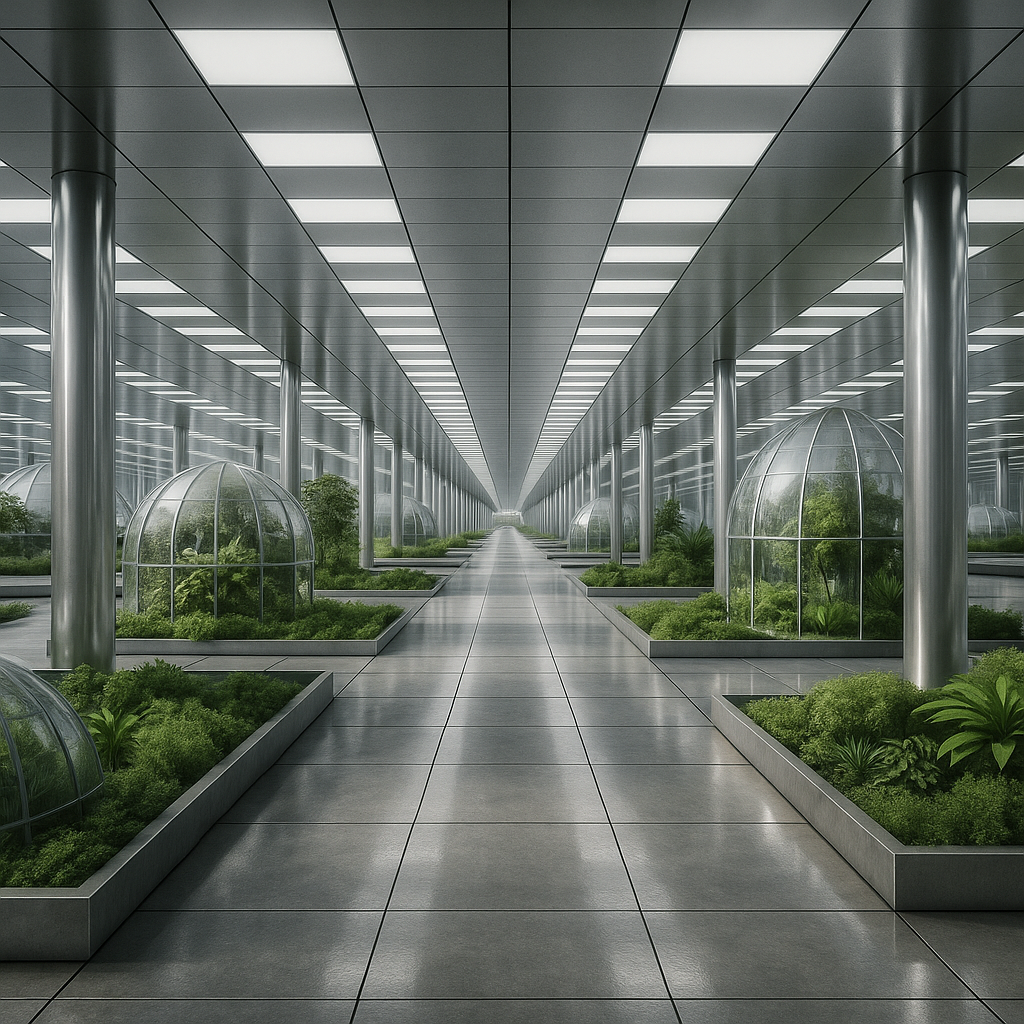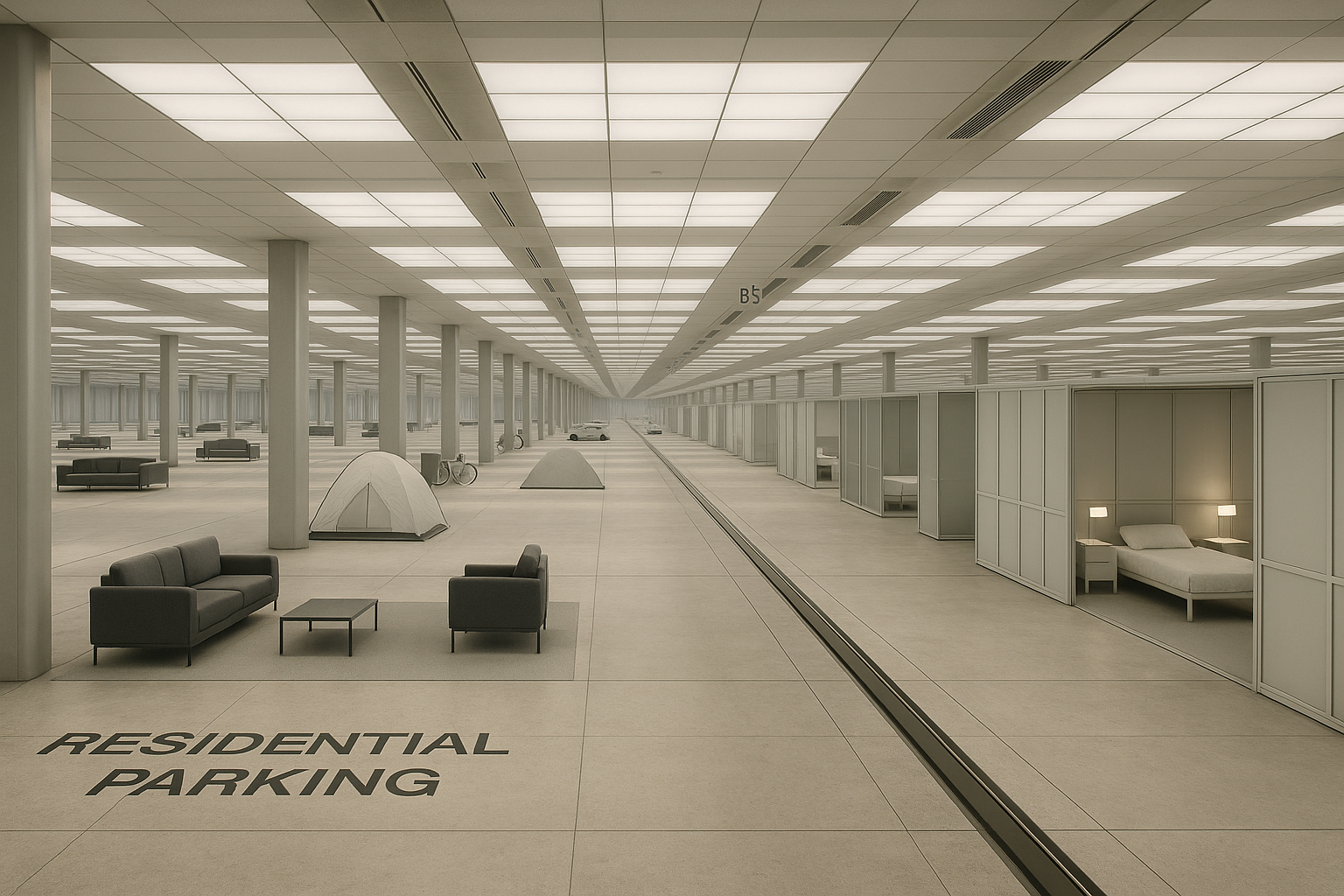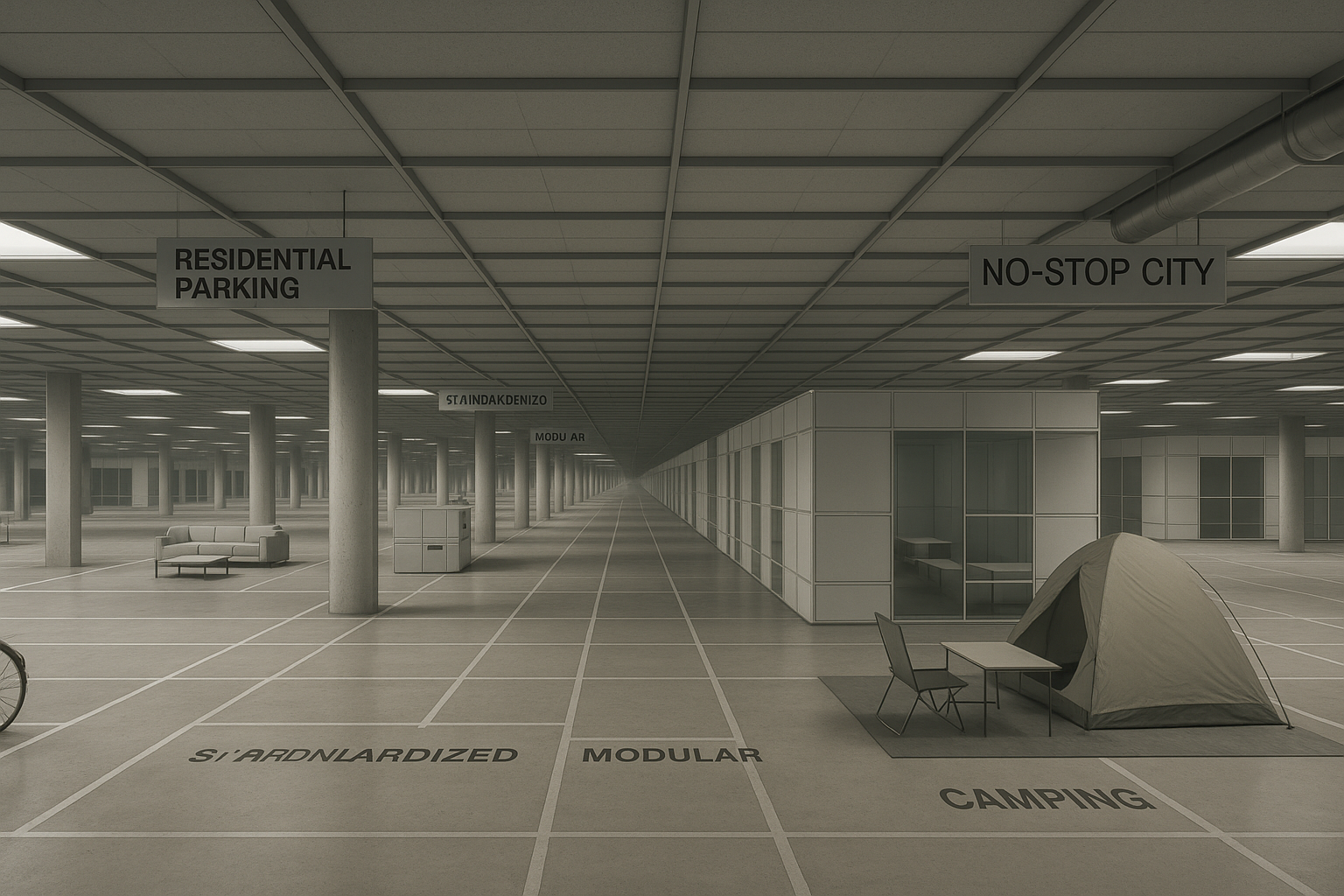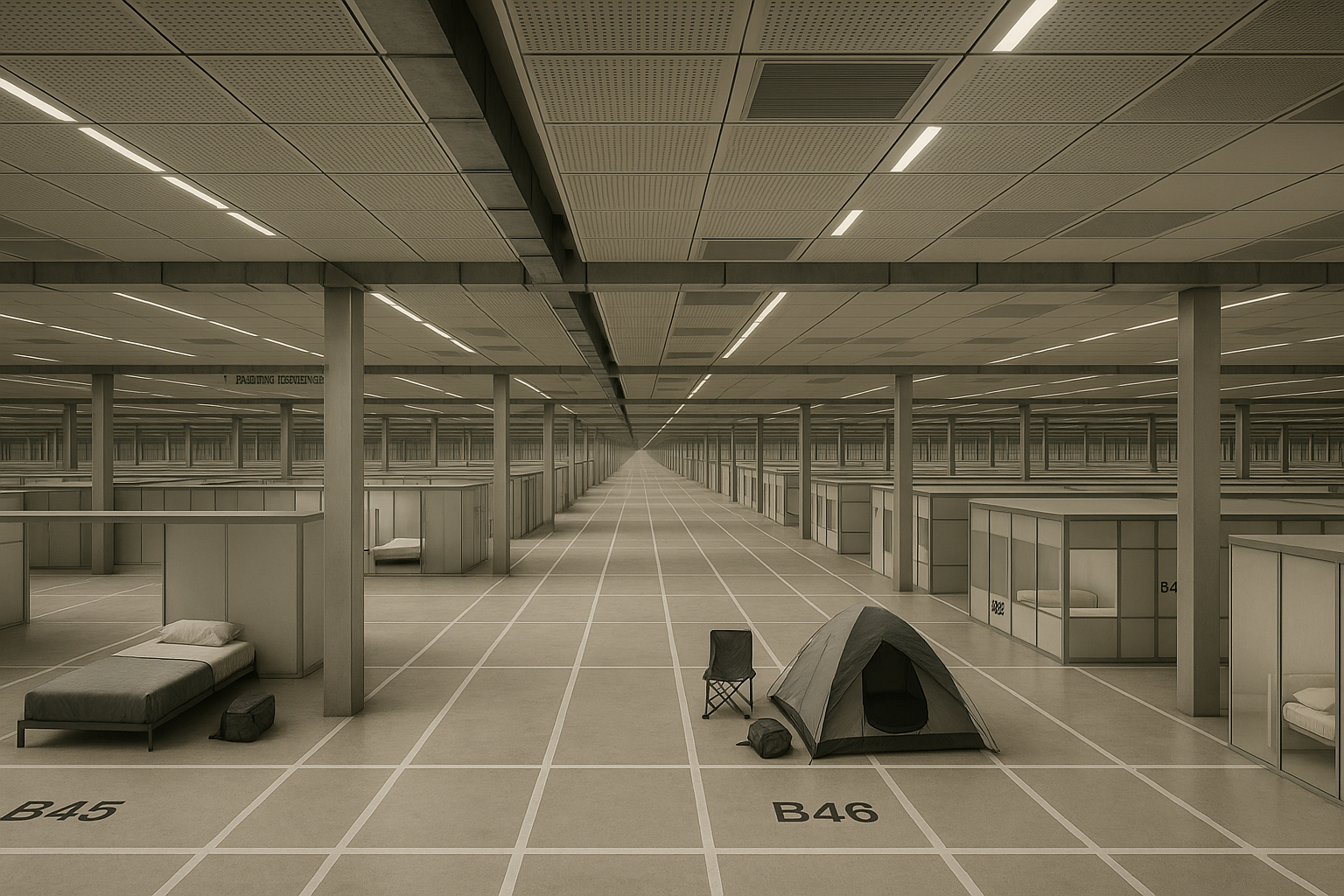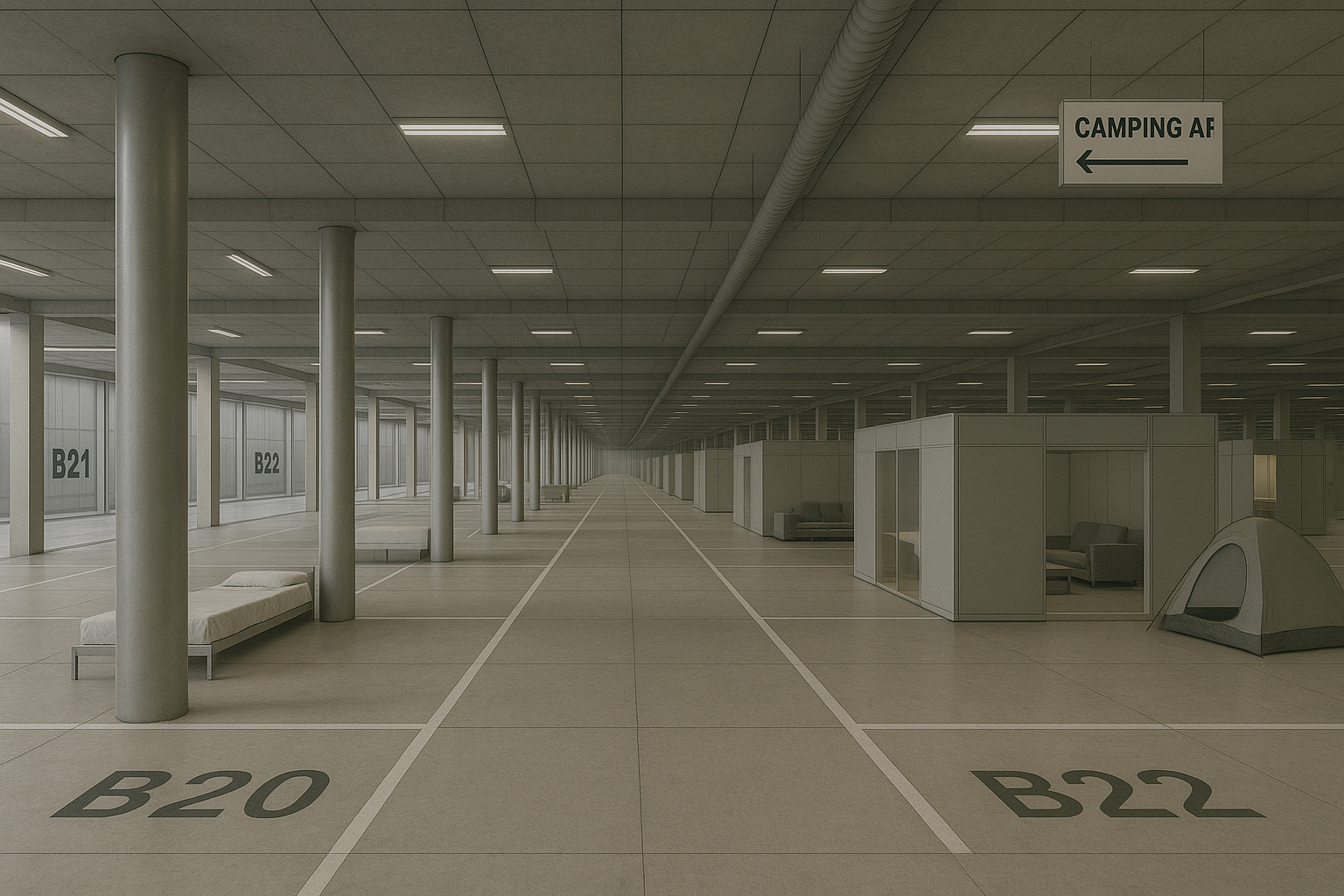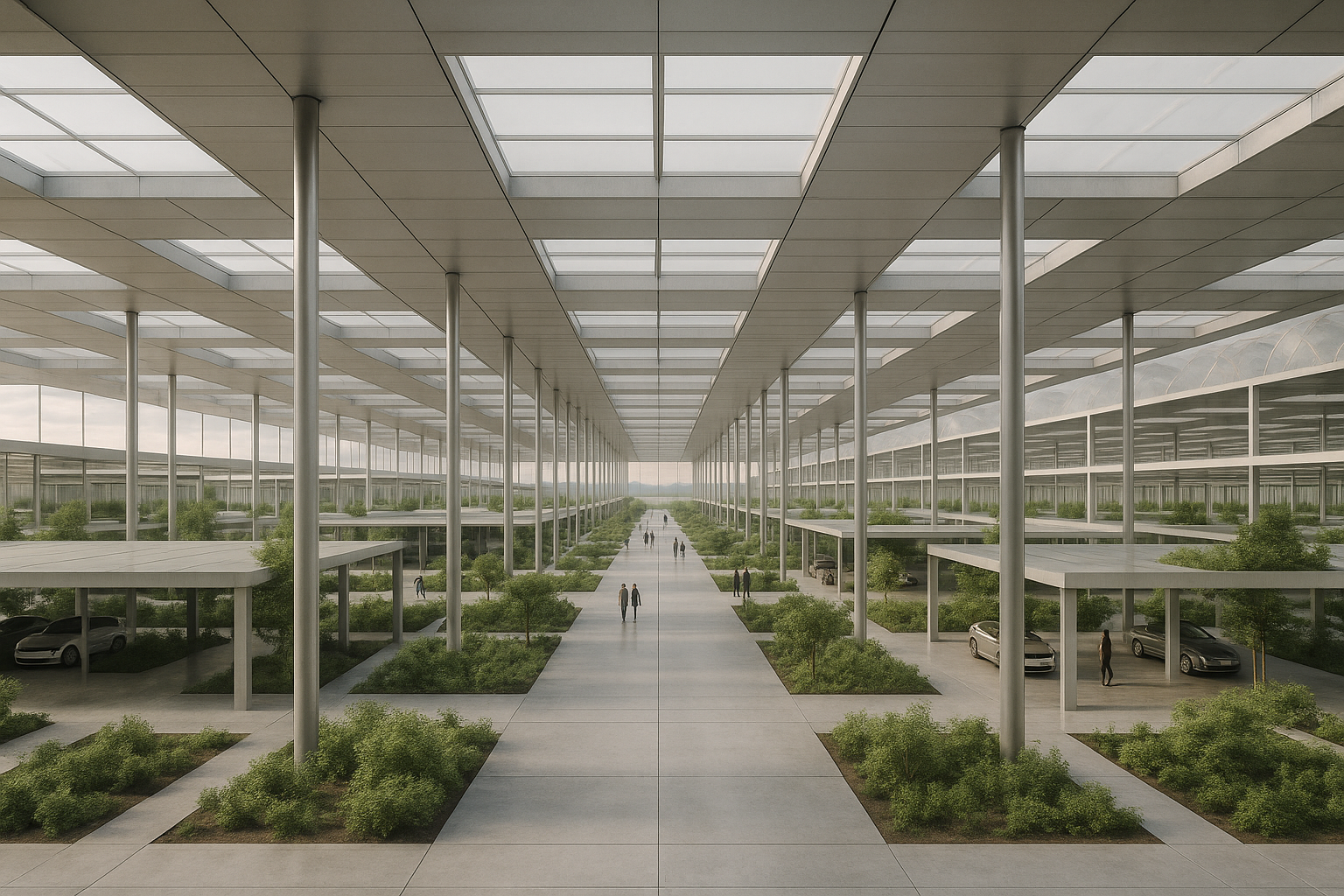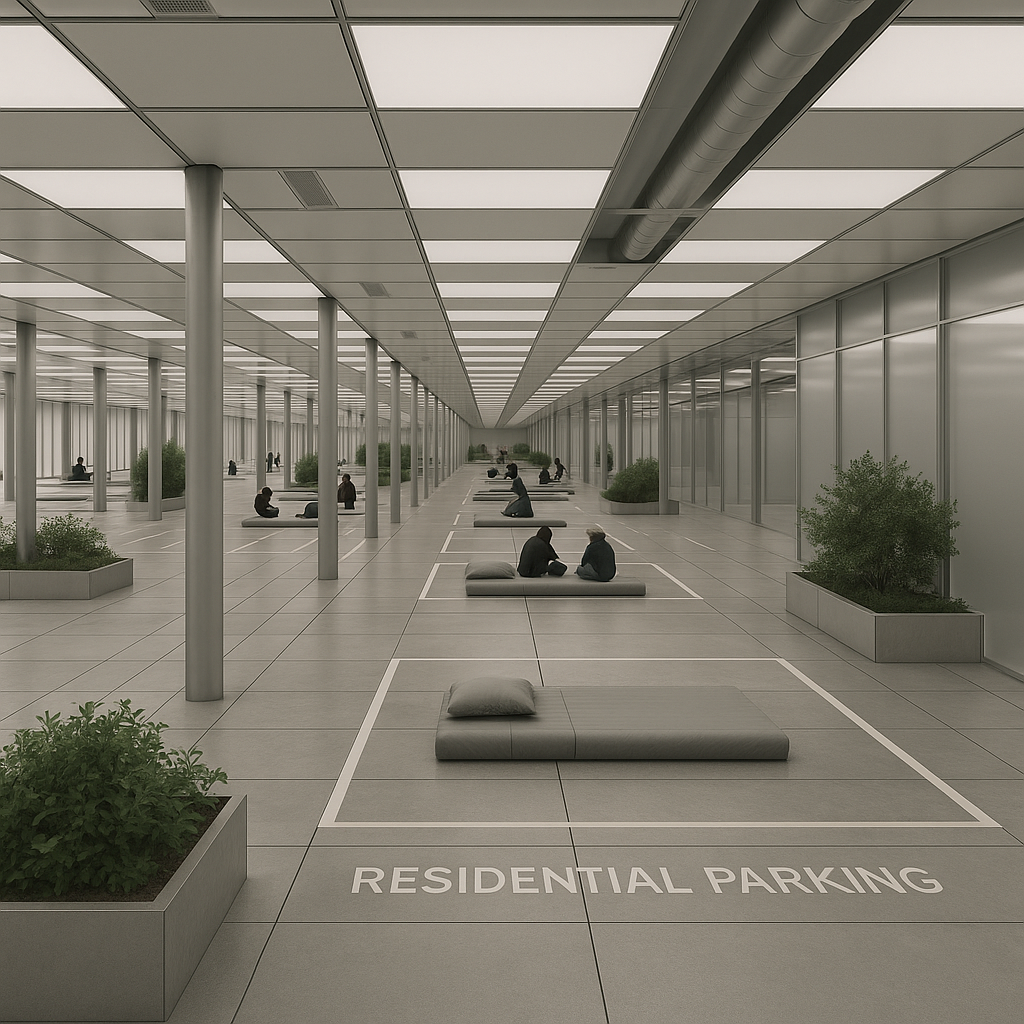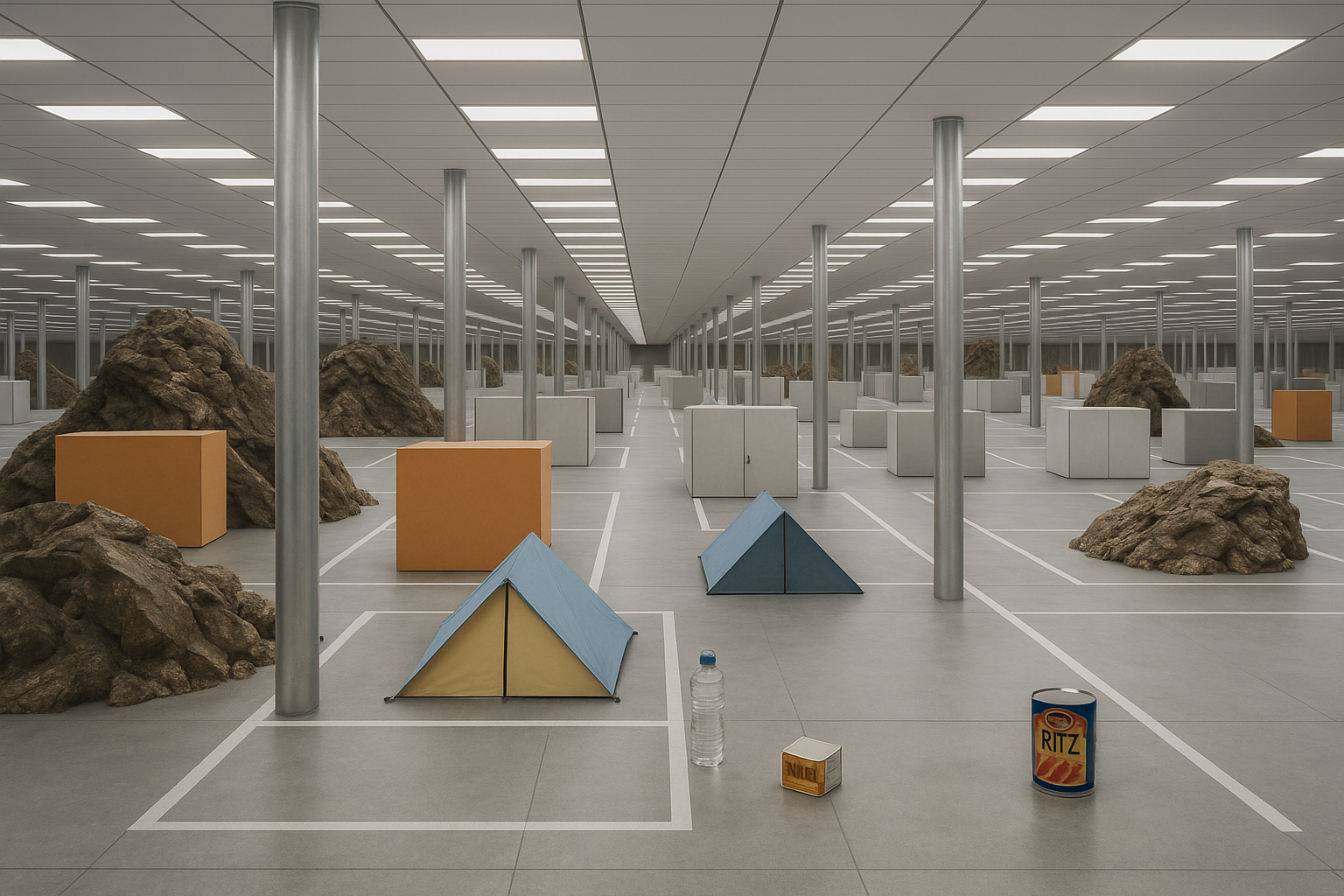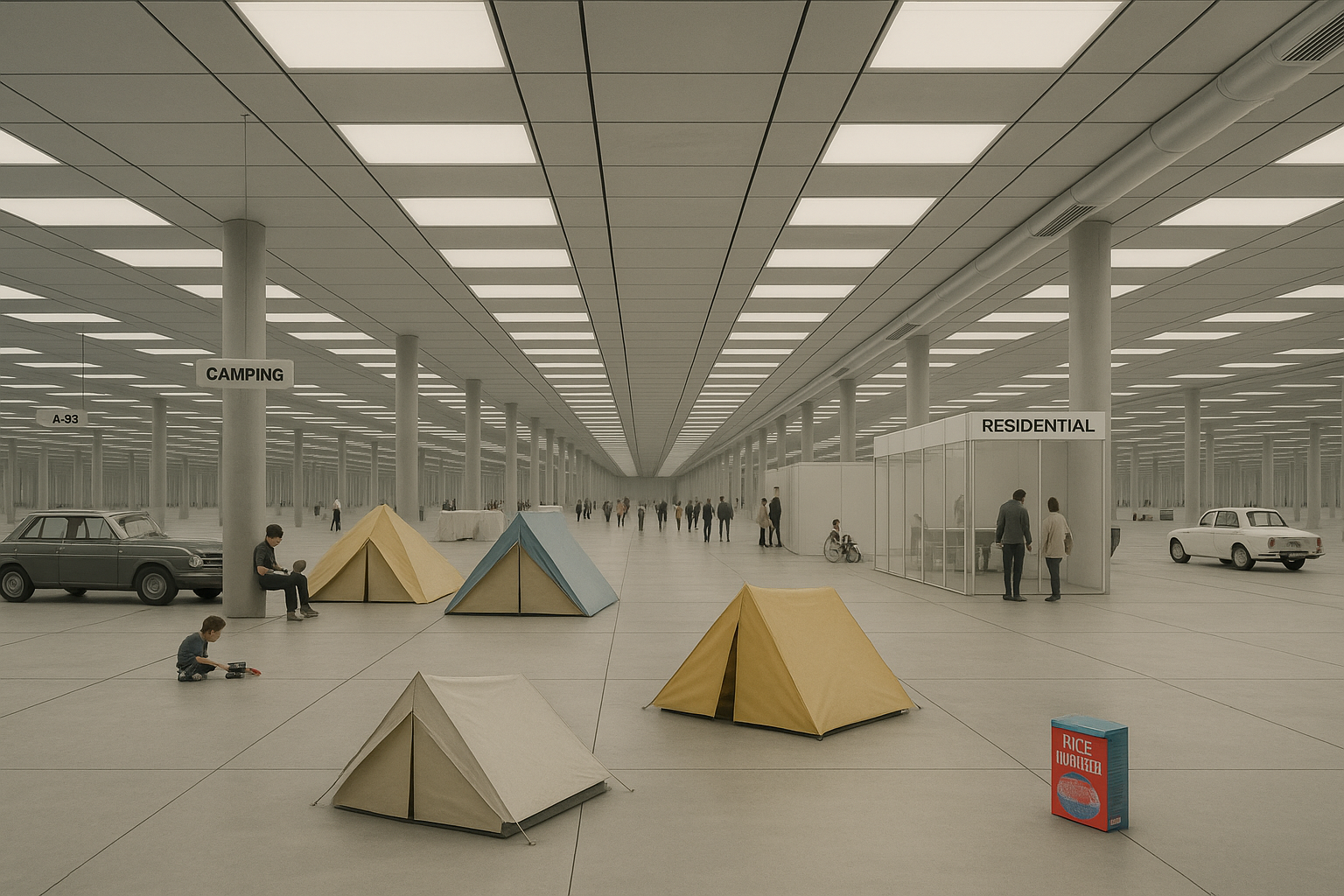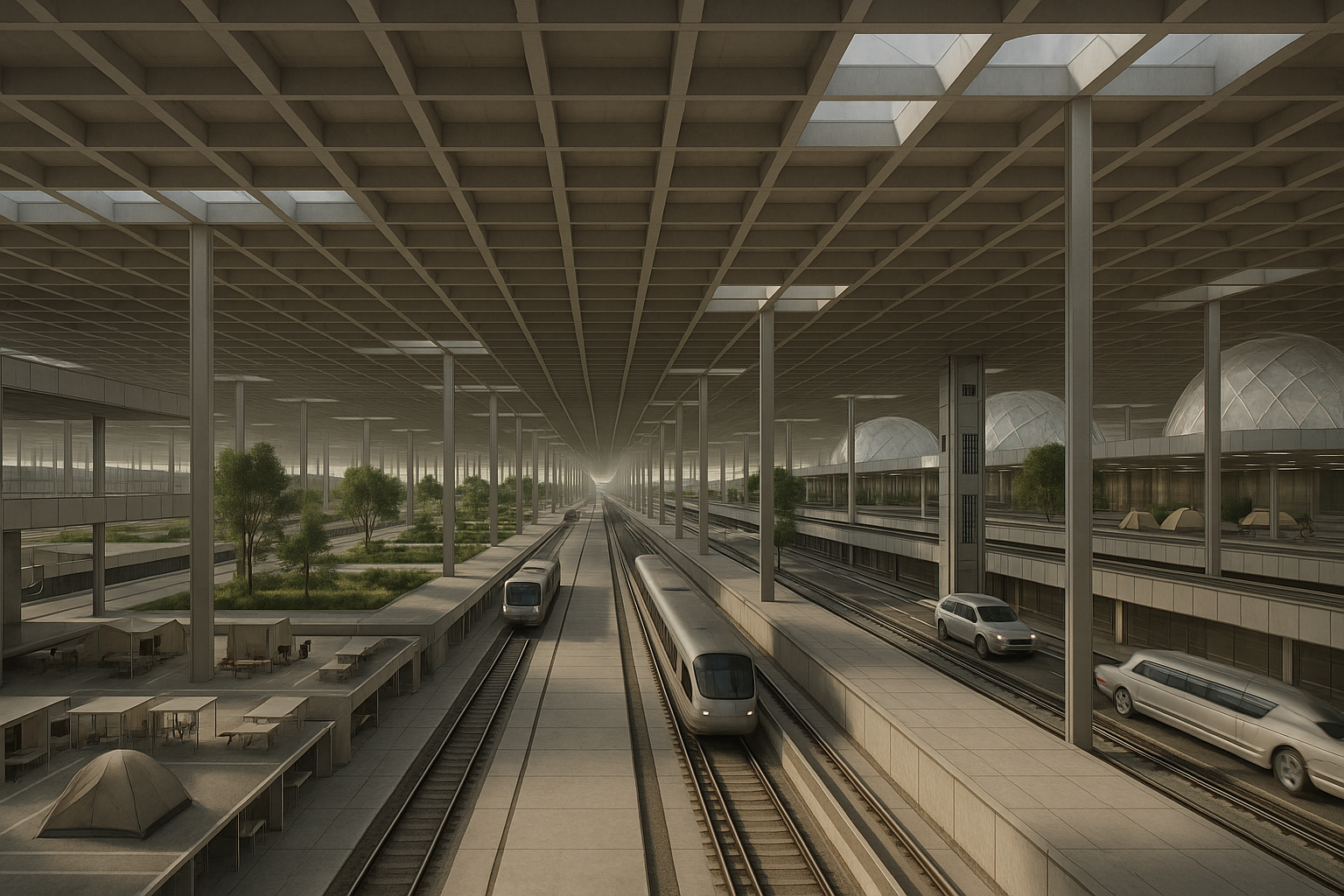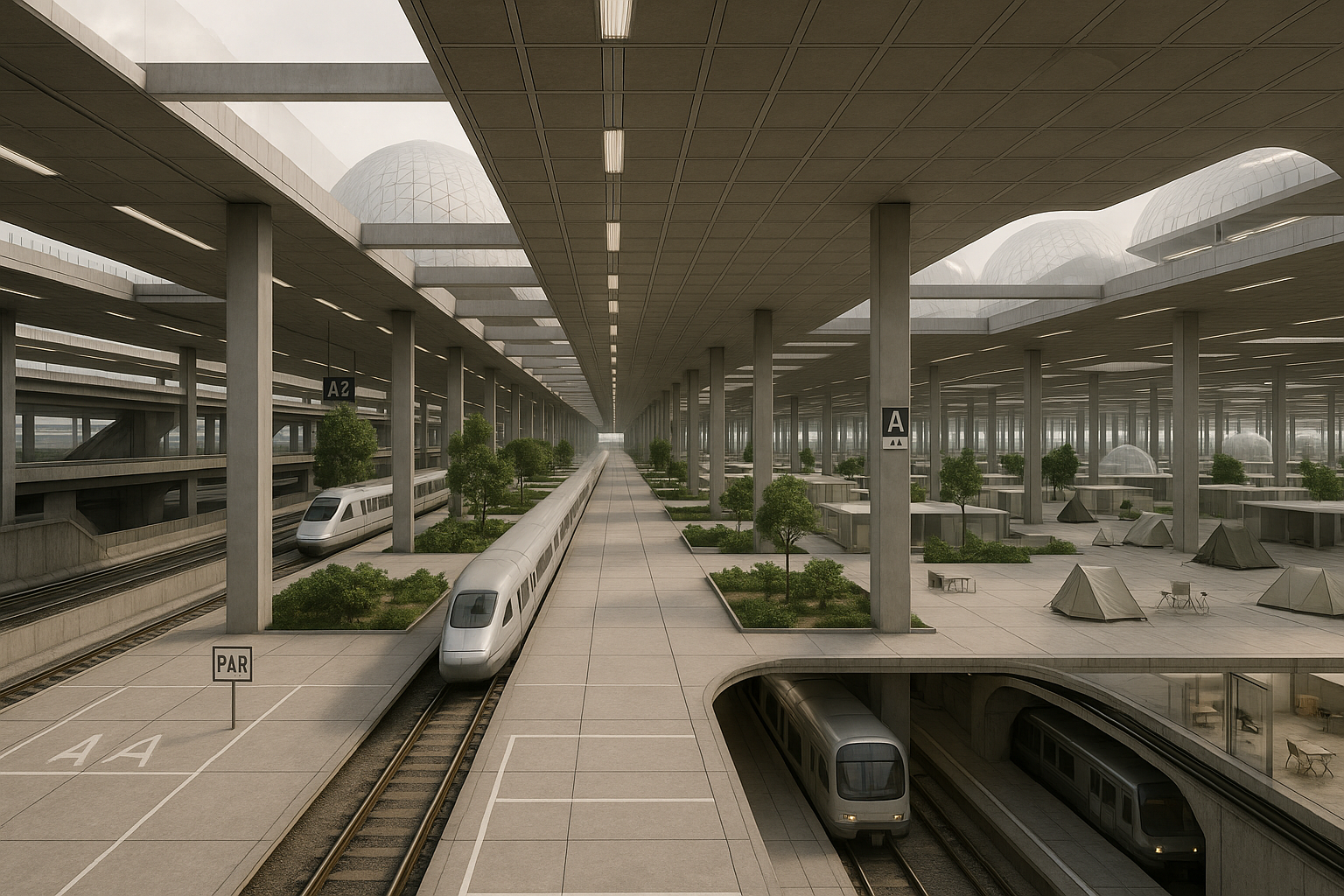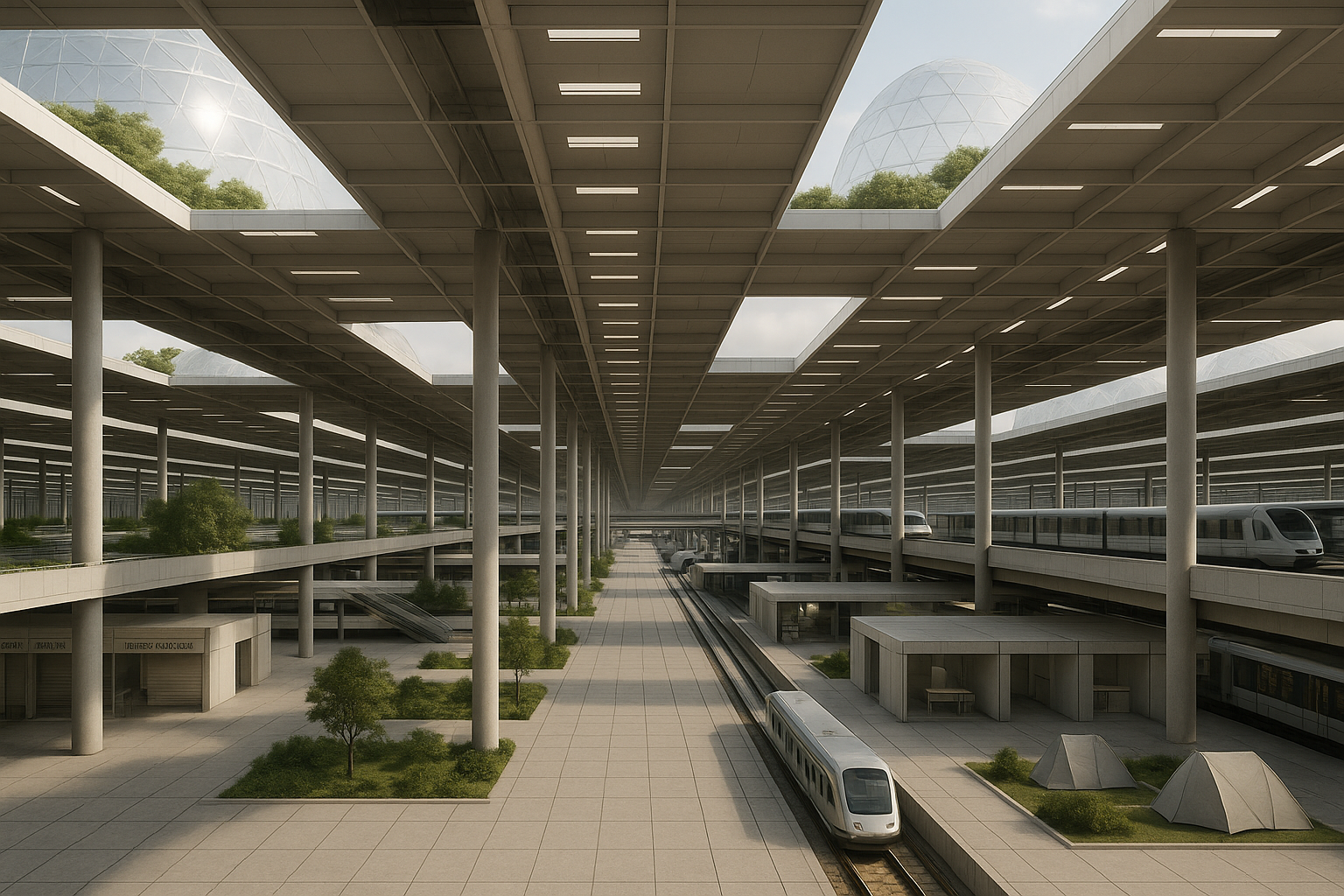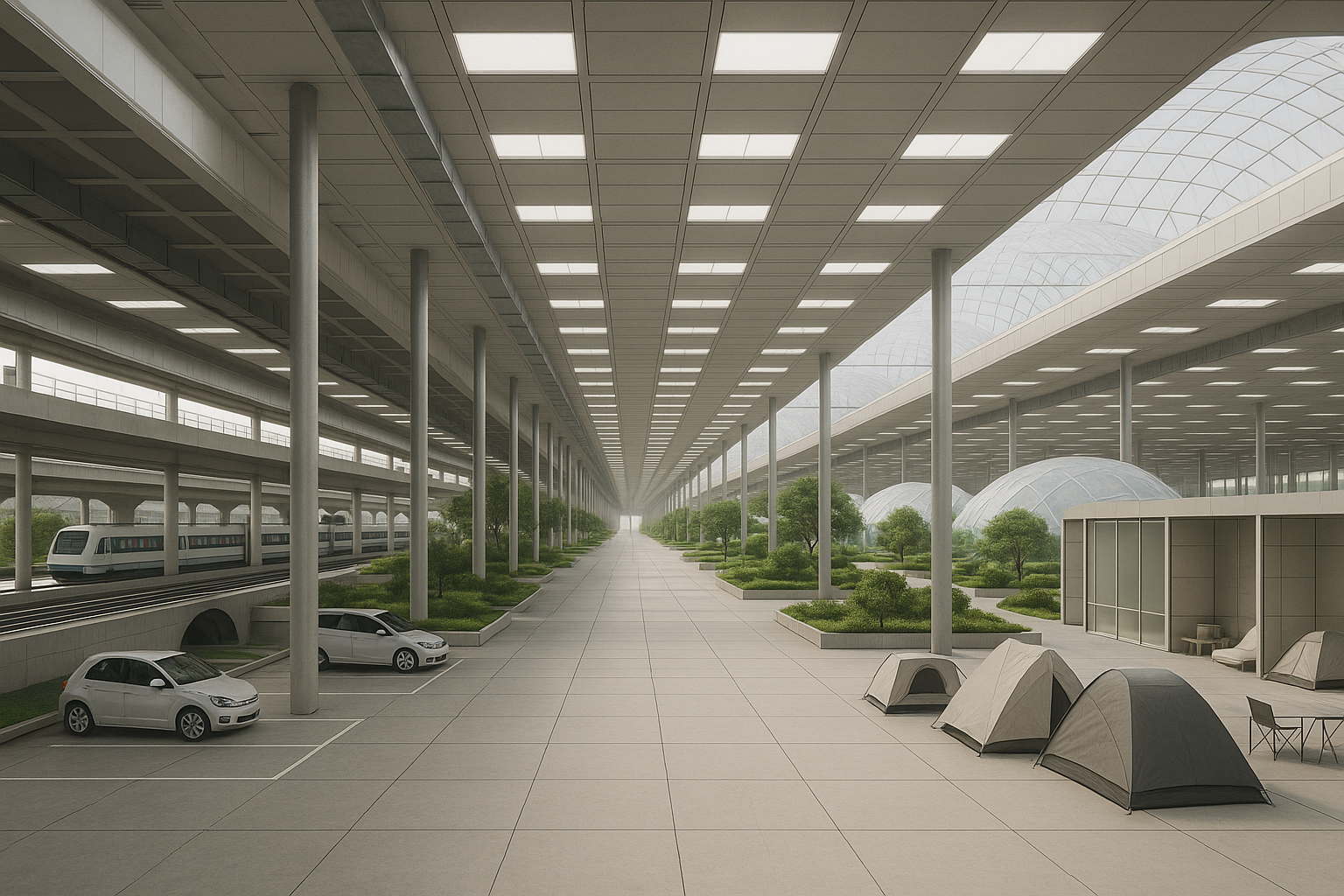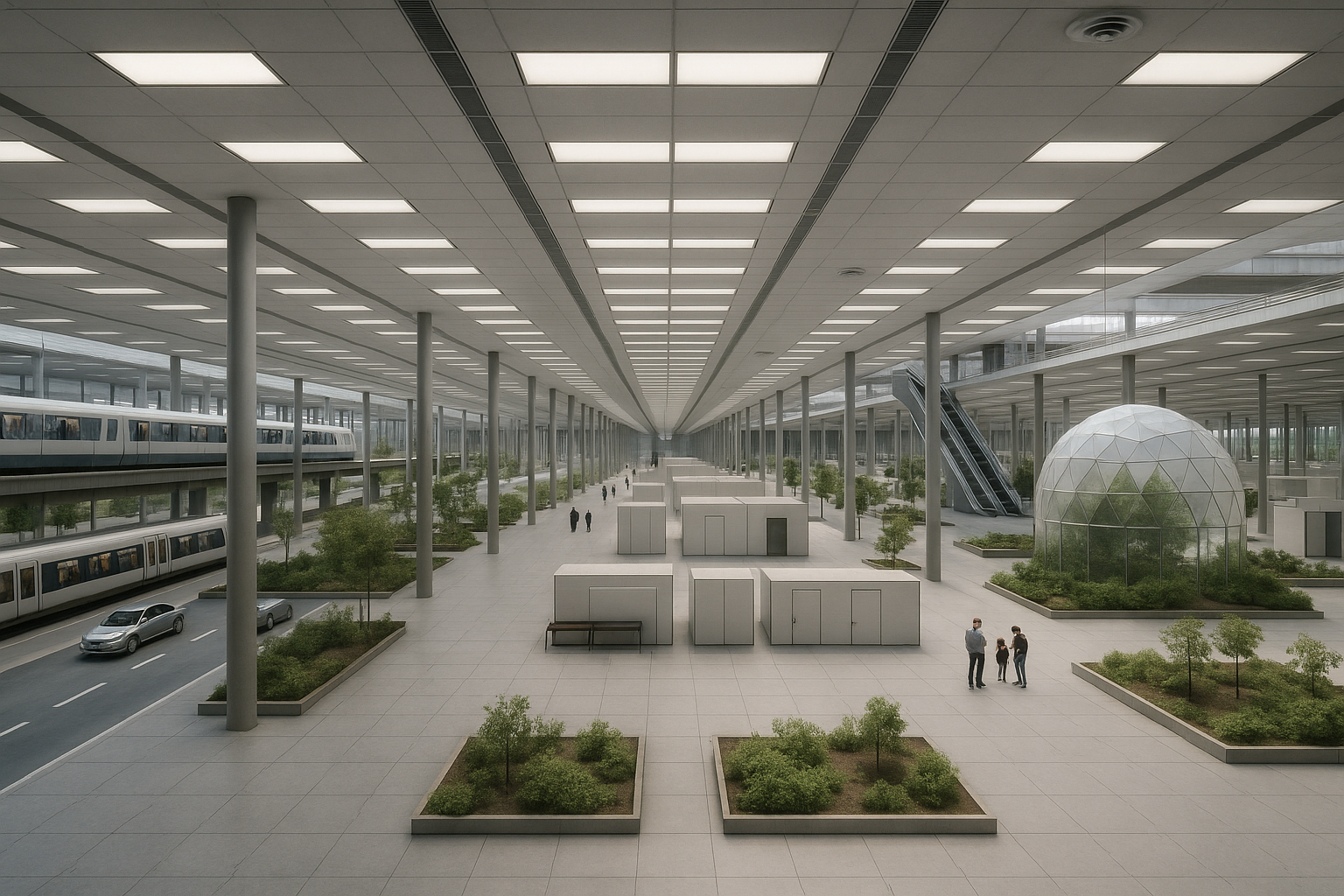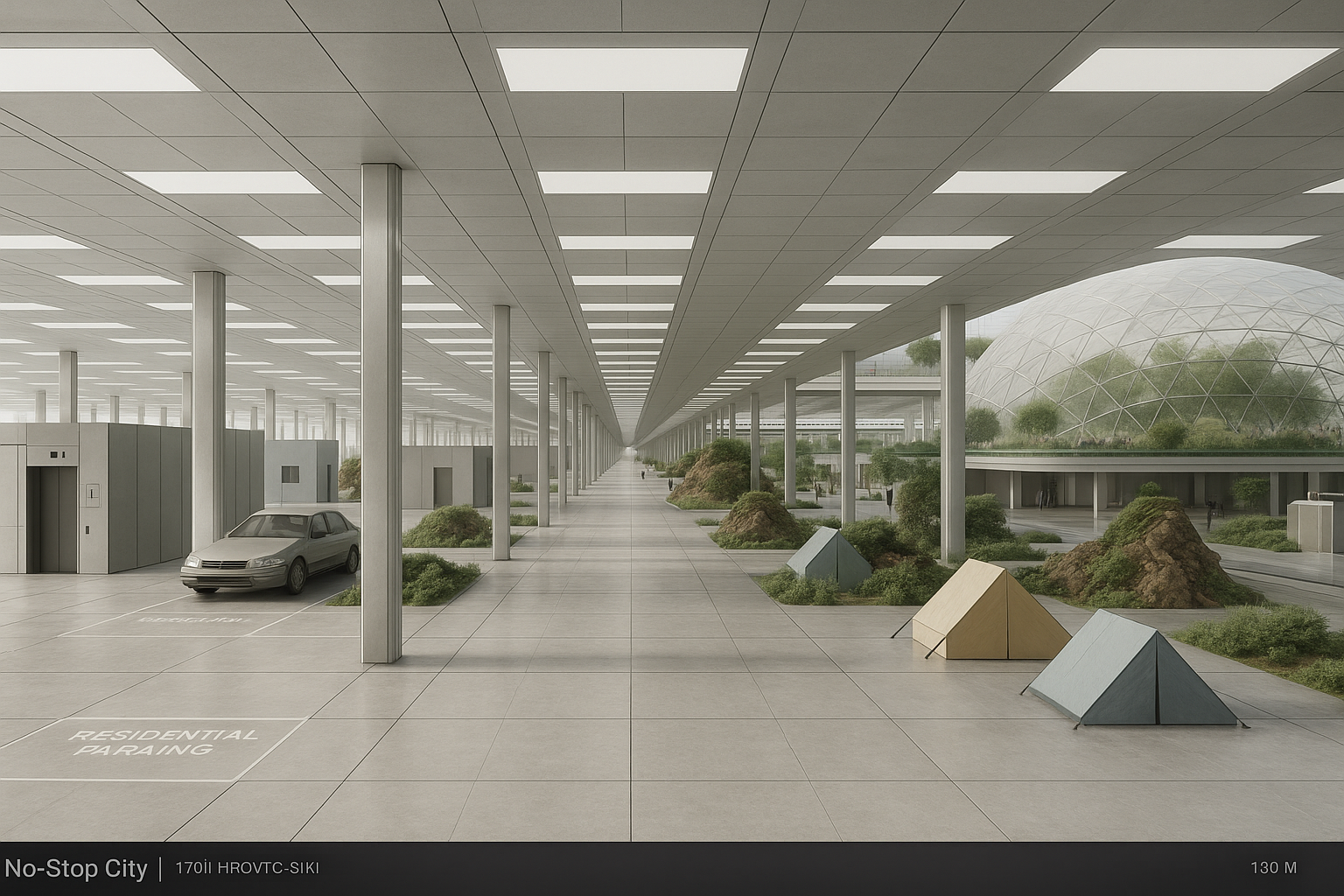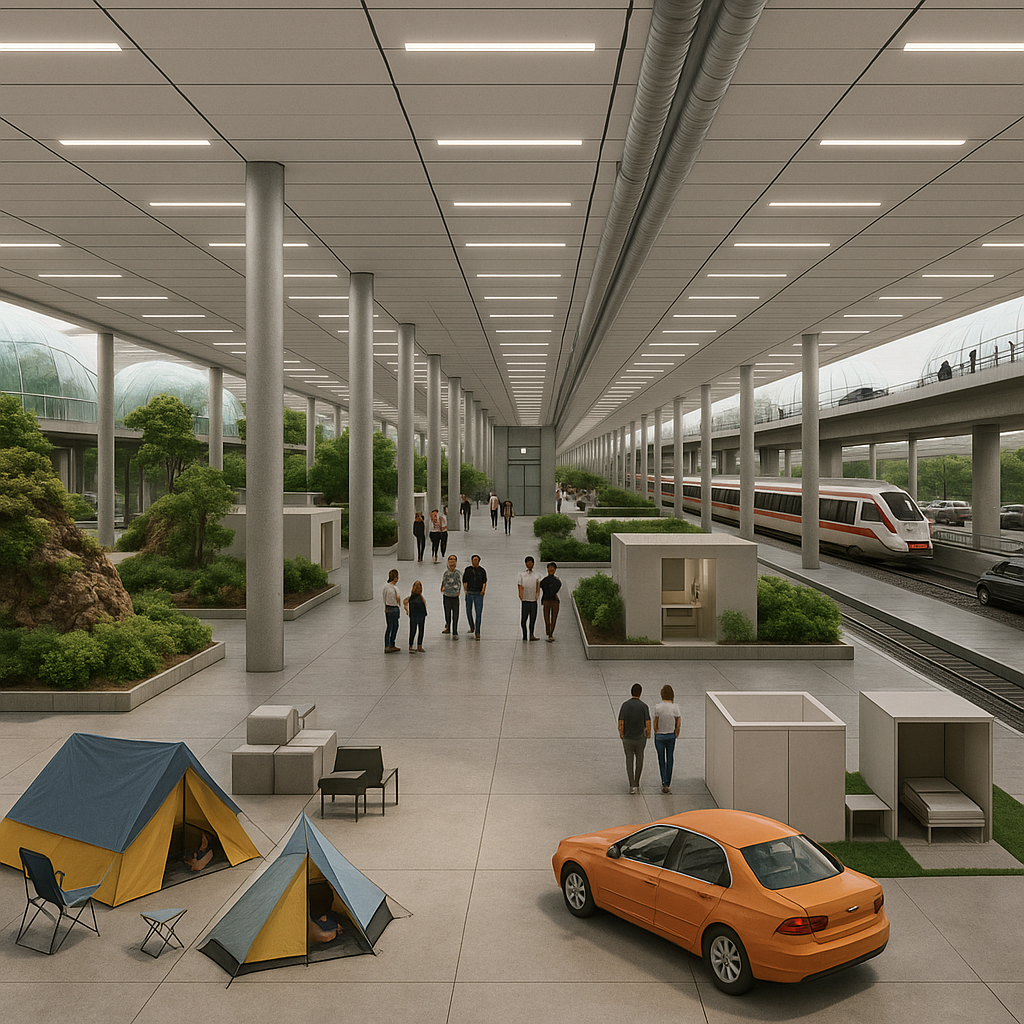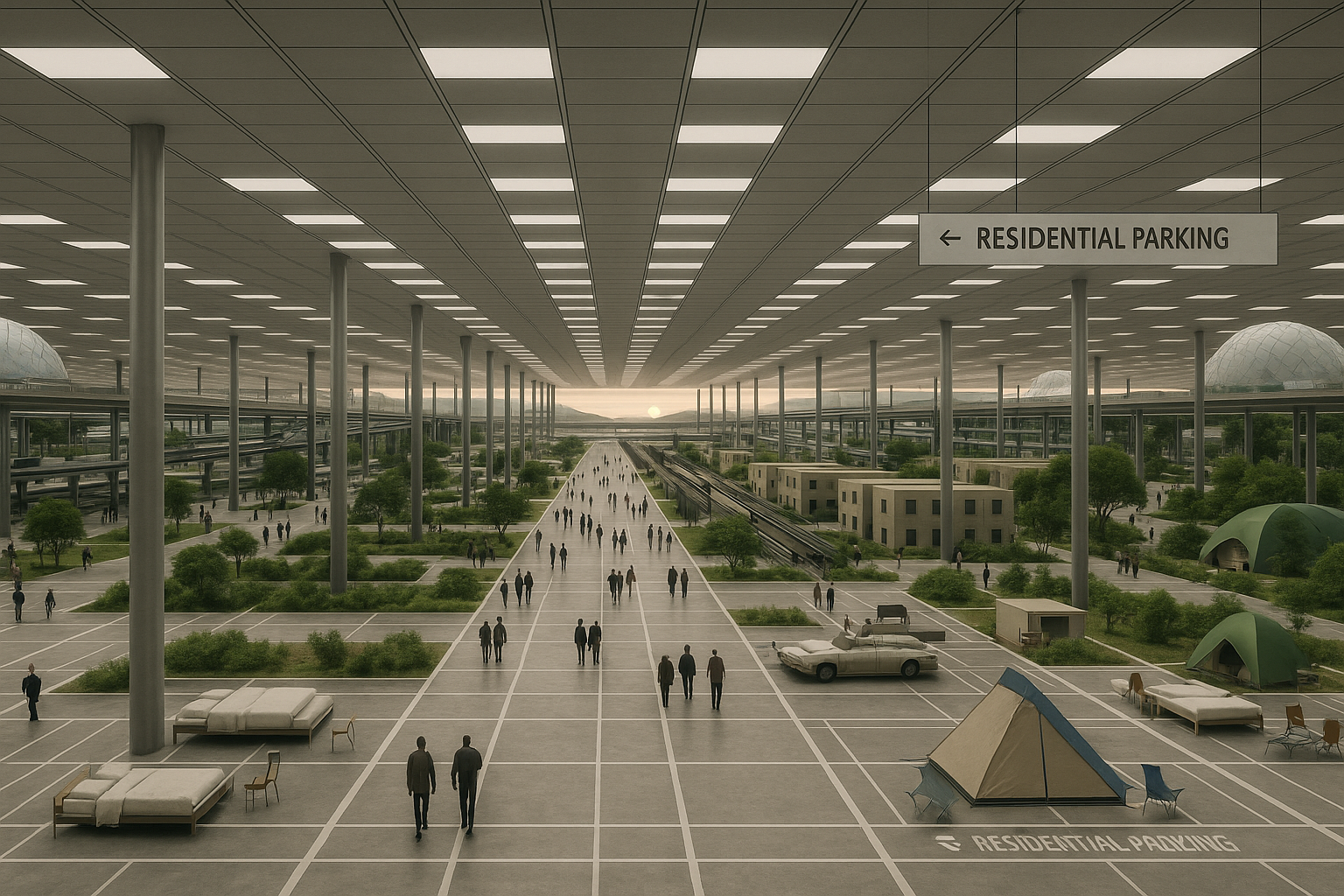No-Stop City de Archizoom
Principais características
Prompt positivo: Ultra-realistic 8K architectural visualization, eye-level perspective of No-Stop City, the utopian vision conceived by Archizoom in 1970. The city is a boundless, autonomous, and infinitely extendable environment — free from external or internal borders, zoning regulations, or functional divisions. It embodies the concept of “architecture without architecture,” presenting a single, monolithic, imperial spatial system that dissolves all hierarchies and urban constraints.
The urban structure unfolds as an immense, sealed box — a continuous, gridded plane of absolute flexibility. Floors stretch out endlessly in linear directions, forming diluted, fluid, and uninterrupted interiors capable of accommodating any and all functions. No-Stop City is not composed of discrete buildings, but of open systems of infrastructure, where spontaneous use, hyper-functionality, and anti-design aesthetics converge into a new model of urban existence rooted in production, consumption, and a manufactured social reality.
Prompt negativo: low resolution, gothic architecture, baroque or neoclassical styles, medieval elements, traditional houses, warm rustic textures, organic shapes, colorful facades, post-apocalyptic ruins, surreal landscapes, fantasy themes, cartoon render, night scene, lush vegetation, ornamental detail, romantic lighting, hand-drawn lines, curved geometry.
Imagens produzidas pelo Chat GPT a partir de entradas de texto
Características formais
Prompt positivo: Ultra-realistic 8K architectural visualization, eye-level perspective of No-Stop City, the utopian vision conceived by Archizoom in 1970. The city unfolds as a vast, monolithic rectangular structure, defined by an infinite repetition of regular lines, planes, volumes, and geometric forms. Floor plans follow a strict orthogonal grid, creating large continuous platforms and spatial levels with no zoning, no hierarchy, and no functional divisions.
The architecture operates as a total system — a seamless field of repetition where every spatial module mirrors the next. From structural layout to surface configuration, the entire city is governed by modular uniformity and absolute spatial neutrality. Its grid can expand endlessly over any territory, without geographic, political, or cultural restriction.
Leisure zones are located on the rooftop, enclosed by translucent geodesic domes. These protective bubbles create controlled environments suspended above the gridded infrastructure, offering programmed spaces for recreation without interrupting the visual logic of infinite continuity.
Rendered under soft natural daylight with hyper-detailed material textures — polished concrete floors, matte modular panels, translucent polymer domes, aluminum structural joints, and fluorescent lighting arrays — the image captures the radical purity of a boundless urban machine. A utopia of form without identity, repetition without limit, and adaptability without anchor.
Prompt negativo: low resolution, fantasy environments, curved or organic architecture, colorful facades, classical ornamentation, gothic or baroque elements, vegetation, post-apocalyptic ruins, medieval design, cyberpunk style, surreal geometry, night scene, romantic or ambient lighting, steampunk details, hand-drawn textures, rustic materials.
Imagens produzidas pelo Chat GPT a partir de entradas de texto
Características de Infraestrutura de Mobilidade
Prompt positivo: Ultra-realistic 8K architectural visualization, eye-level perspective of No-Stop City, the utopian vision conceived by Archizoom in 1970. The city is composed of an immense, monolithic structure defined by regular, modular floor plans and geometric repetition. Vertical movement is organized through a system of elevators that connect the stacked horizontal planes, while the vast interiors remain open and unrestricted — creating fluid, uninterrupted floor levels across the entire urban fabric.
Horizontally, the city is interconnected by a dense network of infrastructure: underground metro tunnels, high-speed trains, and elevated highways seamlessly traverse the space, integrating mobility directly into the architecture. Trains, automobiles, and subways operate continuously alongside streams of nomadic inhabitants who occupy the city in constant motion.
The architectural environment is one of total connectivity — a field of mechanical circulation and spatial neutrality, where movement and repetition define the experience. Rendered in soft natural light with hyper-detailed textures — including polished concrete slabs, aluminum elevator shafts, modular wall panels, fluorescent ceiling grids, reflective metallic corridors, and embedded transport rails — the scene captures a seamless urban machine: automated, infinite, and anti-ornamental.
Prompt negativo: low resolution, organic forms, curved structures, colorful facades, vegetation, post-apocalyptic or ruined settings, fantasy elements, medieval or gothic details, baroque ornamentation, soft lighting, hand-drawn effects, cyberpunk aesthetics, surrealism, night scene, rustic or natural materials.
Imagens produzidas pelo Chat GPT a partir de entradas de texto
Características dos Espaços Verdes
Prompt positivo: Ultra-realistic 8K architectural visualization, eye-level perspective of No-Stop City, the utopian vision conceived by Archizoom in 1970. The city is conceived as an infinite, modular, monolithic structure where nature and technology coexist within a seamless urban system.
Vegetation is not confined to the periphery — it becomes part of the architectural grid. Green spaces are integrated into the continuous floor levels, occupying sections of the open-plan interiors, weaving through the structural pilotis, and flourishing across the expansive rooftop terraces. The result is a rational, machine-like environment softened and recontextualized by embedded elements of nature.
The fusion between organic life and industrial infrastructure defines a new form of urbanity — one where modular repetition, technological systems, and spontaneous greenery coexist in spatial equilibrium. Rendered in soft natural daylight with hyper-detailed materials — including matte aluminum columns, polished concrete floors, modular planting beds, translucent panels, fluorescent lighting, and clusters of green vegetation — the image evokes a sterile yet inhabited dreamscape: a city of infinite extension, human adaptability, and ecological tension.
Prompt negativo: low resolution, fantasy environments, curved architecture, colorful facades, rustic textures, classical ornamentation, gothic details, post-apocalyptic ruins, surreal landscapes, cyberpunk or steampunk aesthetics, cartoon styles, night scene, foggy lighting, warm romantic atmosphere, excessive vegetation, historical buildings.
Imagens produzidas pelo Chat GPT a partir de entradas de texto
Características Espaciais e Funcionais
Prompt positivo: Ultra-realistic 8K architectural visualization, eye-level perspective of No-Stop City, the utopian vision conceived by Archizoom in 1970. The city is composed of optimized and potentially infinite urban structures, organized into a seamless, rational system. All environments are artificially climatized, with regulated, neutral lighting that eliminates variation and reinforces spatial uniformity.
Every element of the city reflects capitalist logic — production, repetition, and spatial control — in pursuit of a universal urbanism that remains identical in any part of the world. The architecture is modular, open-plan, and devoid of geographic specificity, forming a continuous field of programmable surfaces.
Residential life in No-Stop City is structured through three coexisting typologies. The first is the Residential Parking model: housing units are marked like parking spaces, entirely open and accessible, with no enclosures — designed for a nomadic population to temporarily inhabit. The second consists of standardized modular units, endlessly repeatable and mass-produced for permanent or transitional occupancy. The third mode is based on camping-style occupation, where only the infrastructural services are fixed — leaving the surrounding space open for temporary, flexible, user-defined configurations.
Rendered with soft, diffuse lighting and hyper-detailed materials — matte aluminum columns, polished concrete surfaces, translucent partitions, grid-based fluorescent panels, integrated ventilation ducts, and minimalist signage — the image captures the clinical, industrial aesthetics of a world-machine built for total functionality, repetition, and unrestricted expansion.
Prompt negativo: low resolution, fantasy landscapes, curved architecture, organic shapes, traditional homes, classical or gothic ornamentation, warm rustic textures, surrealist composition, vegetation overgrowth, post-apocalyptic ruins, cyberpunk or steampunk styles, romantic lighting, night scene, baroque elements, colorful facades, historic references, cartoon render.
Imagens produzidas pelo Chat GPT a partir de entradas de texto
Todos os prompts anteriores.
Prompt positivo: Ultra-realistic 8K architectural visualization, eye-level perspective of No-Stop City, the utopian vision conceived by Archizoom in 1970. The city is conceived as an infinite, modular, and monolithic structure — a boundless, autonomous environment free of external or internal borders, zoning regulations, or functional divisions. It embodies the notion of “architecture without architecture,” unfolding as a sealed, grid-based megastructure of pure continuity and spatial neutrality.
Floor plans follow a strict orthogonal grid, composed of repeating lines, planes, and regular geometric forms. The space is fluid and uninterrupted, capable of accommodating any function spontaneously. Modular repetition governs every level — from surface finishes to structural layout — dissolving hierarchy in favor of infinite flexibility. The city expands without limitation over any landscape, unbound by geography, culture, or politics.
Vertical movement is achieved through elevator shafts that connect open, stacked floor levels. Horizontally, the city is interwoven with infrastructure: underground metro tunnels, high-speed railways, and elevated highways enable constant mobility. Trains, subways, vehicles, and nomadic inhabitants circulate fluidly, forming a landscape of perpetual motion.
Nature is embedded within the grid. Vegetation is not peripheral — it integrates into open-plan interiors, structural pilotis, and vast rooftop terraces. These green zones coexist with the industrial logic of the city, generating a hybrid environment where modular technology and spontaneous nature converge.
Residential life is organized into three coexistive typologies:
• Residential Parking — housing zones marked like parking lots, fully open, unenclosed, and accessible for temporary nomadic occupation.
• Standardized Modules — mass-produced living units, endlessly repeatable, designed for either transitional or permanent use.
• Camping Zones — infrastructure provides only the basic services, leaving open space for user-defined, temporary configurations.
Recreation areas are found on the rooftop, enclosed by translucent geodesic domes that maintain the city’s continuity while offering programmed leisure environments. All spaces are artificially climatized, with regulated neutral lighting and controlled air systems, reinforcing a sense of spatial uniformity and mechanical precision.
Rendered in soft natural daylight with hyper-detailed materials — polished concrete flooring, matte aluminum columns, translucent polymer domes, modular wall panels, fluorescent lighting grids, exposed ventilation ducts, and minimal signage — the scene captures the radical purity of a planetary machine-city. A vision of infinite repetition, structural logic, spatial neutrality, ecological insertion, and adaptable human occupation.
Prompt negativo: low resolution, fantasy aesthetics, curved or organic architecture, colorful facades, vegetation overgrowth, ruins, post-apocalyptic settings, gothic or baroque ornamentation, classical buildings, retro-futuristic style, cyberpunk or steampunk themes, hand-drawn effects, surreal landscapes, soft romantic lighting, night scenes, cartoon rendering, rustic textures.
Imagens produzidas pelo Chat GPT a partir de entradas de texto
